AMD Radeon RX 6800 and RX 6800 XT review: Reclaiming the high end - garciaeary1996

At a Glance
Expert's Rating
Pros
- Excellent 4K and 1440p gaming
- Much better 1080p performance than GeForce
- 16GB memory capacity
- Ray tracing at 1440p and 1080p
- Vastly built cooler
- Gets faster when matched with Ryzen 5000
- Monetary standard length and power pins
Cons
- Ray tracing is faster on GeForce GPUs
- Nobelium resolution to Nvidia's DLSS
Our Verdict
AMD's Radeon RX 6800 outperforms the RTX 3070 and offers twice as much memory, easily justifying its higher price. It send away get flat quicker paired with a Ryzen 5000 CPU, only Nvidia's rival GeForce GPUs give a ray trace advantage.
Best Prices Today

$580
With the debut of the Radeon RX 6800 and RX 6800 XT, AMD is clearly connected a roll.
Plain weeks ago, the company's Ryzen 5000 processors seized the univocal public presentation lead from Intel—yes, even in games—for the first time in over a decade. Happening Wednesday, IT's the graphics naval division's turn to shine with these two Radeon RX 6000-serial publication "Vainglorious Navi" graphics cards powered by AMD's new RDNA 2 computer architecture.
Rival Nvidia has largely been competing against itself in the high-end GPU space for several years right away. AMD's Vega offerings showed up disappointingly late and disappointingly underpowered in 2017, followed by (awesome) first-gen RDNA card game that sadly topped out with the midrange Radeon RX 5700 XT in 2019. The Radeon RX 6000-series ends Nvidia's run.
AMD's $579 Radeon RX 6800 dominates Nvidia's GeForce RTX 3070 across the gameboard in longstanding games. The $649 Radeon RX 6800 XT trades blows with the GeForce RTX 3080 at 4K solving and often wins outright at lower resolutions, for $50 to a lesser degree Nvidia's flagship. Both card game come equipped with vastly upgraded coolers and beefy 16GB memory setups that leave Nvidia's VRAM sounding downright meagerly in comparison. They are further bolstered by an innovative new "Infinity Cache" technology that cribs ideas from AMD's server processors. And yes, RDNA 2 adds proper-time ray tracing to Radeon's armory—though, crucially, no DLSS rival.
Welcome back to the adenoidal end, AMD. The Radeon RX 6800-series comes set to play tomorrow's games just As symptomless A today's. Let's pitch in. There's a good deal to cover, so if you want to jump to a specific section, use one of the handy links below:
- Radeon RX 6800-Serial publication: Specs, features, and RDNA 2
- Radeon RX 6800 and 6800 XT material design
- Better with Ryzen: AMD Fashionable Access Memory
- Our trial run system
- Radeon RX 6800 and 6800 XT gaming benchmarks
- Radeon RX 6800 and 6800 XT ray trace performance
- Power draw, thermals, and noise
- Should you buy the Radeon RX 6800 or 6800 XT?
[ Further reading: Top-quality graphics card game for Personal computer gaming ]
Radeon RX 6800-serial publication: Glasses, features, and RDNA 2
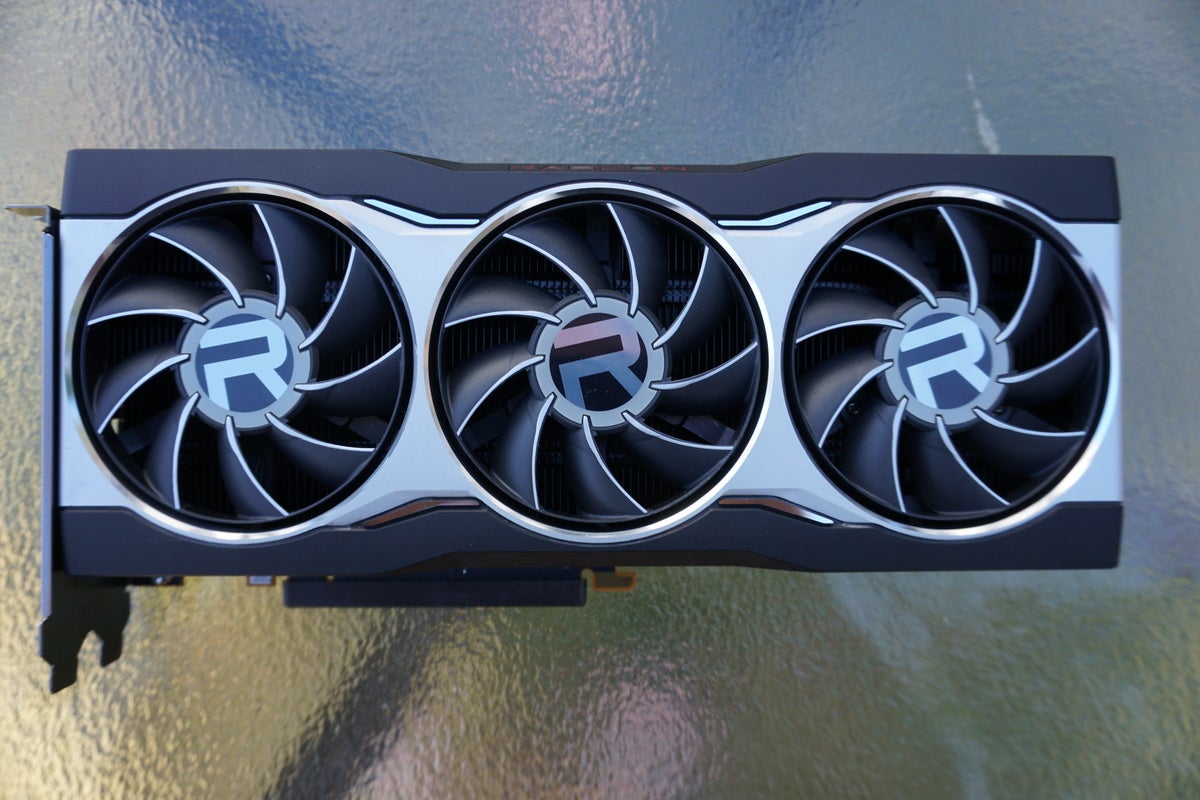 Brad Chacos/IDG
Brad Chacos/IDG Graphics processors built using AMD's upgraded RDNA 2 architecture beat in the heart of the Radeon RX 6800 and 6800 XT, packed with more, well, everything than their predecessors. The new 7nm GPUs include more than compute units, more stream processors, more memory, more ROPs, higher speeds, you name information technology:
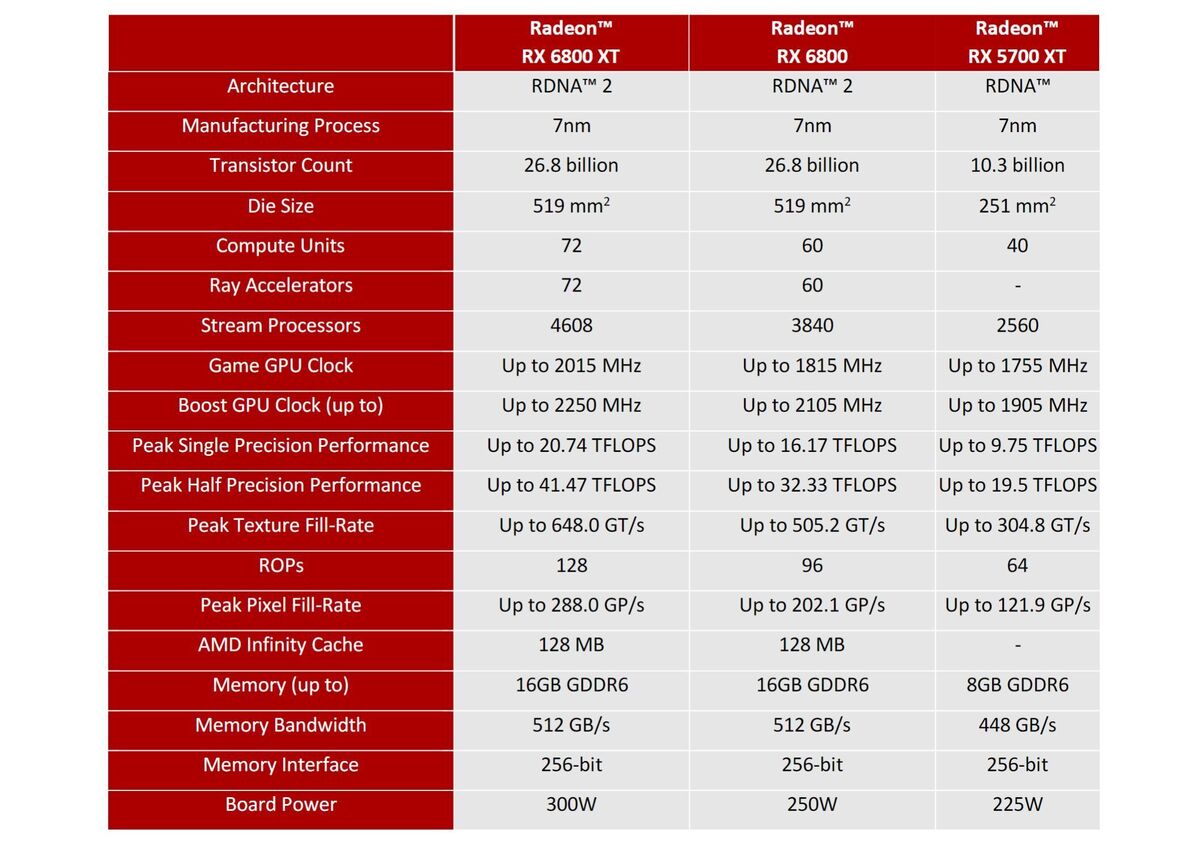 AMD
AMD RDNA 2's ultimate 80-compute-unit incarnation volition hit the streets as the $999 Radeon RX 6900 XT, which will challenge Nvidia's $1,500 GeForce RTX 3090 when it launches December 8. We devoted an entire article to what's new inside the RDNA 2 computer architecture if you're interested in encyclopedism more, just we'll stumble the highlights present.
The Radeon RX 6000-series hits such higher clock frequencies than its predecessors (and rivals), with the both the Radeon RX 6800 and 6800 XT exceptional the 2GHz roadblock at peak speeds. They stay fast even under lode. The Radeon RX 6800 XT is rated for a 2,015MHz Halt Time—AMD's terminal figure for the expected frequency during gameplay—and boosts all the way adequate a ludicrous 2,250MHz in extraordinary scenarios. Activating the untested, optional "Furore Modality" in Radeon Software on the Radeon RX 6800 XT can send the add-in high symmetrical higher by increasing the power confine and buff speeds. Alternatively you rear end rouse Quiet mode for much cooler, quieter mental process and a plain one-per centum hit to performance, AMD says. (Furor mode isn't available on the non-XT 6800.)
 AMD
AMD First-gen RDNA graphics cards couldn't hit these speeds for many reasons, but the memory subsystem was part of it. The Radeon RX 5000-series simply couldn't scale up as far as these unprecedented Radeon RX 6000-series GPUs can without becoming starved for memory board bandwidth, AMD engineers said. This generation of cards includes a revolutionary "Infinity Stash" to help with the trouble.
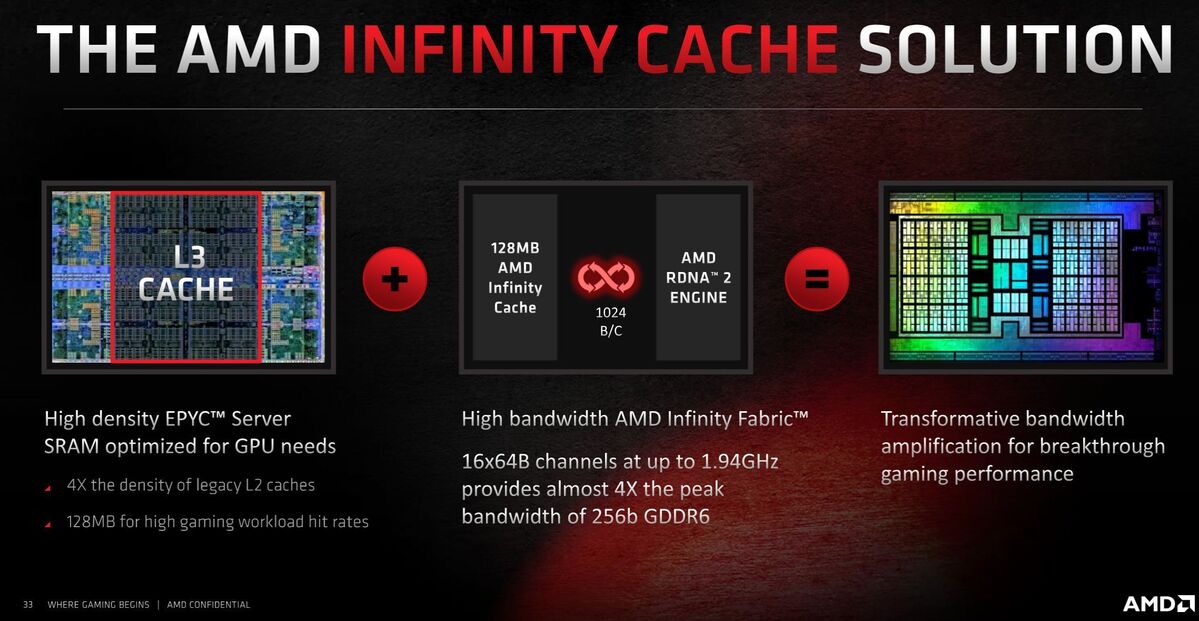 AMD
AMD The Radeon RX 6800, 6800 XT, and forthcoming 6900 XT all include a massive 128MB Infinity Cache baked right into their GPUs. It's essentially a heavy chunk of L3 SRAM elysian past a similar configuration in AMD's Epyc processors, but four multiplication denser and optimized for gambling workloads. (Ryzen processors also recently adoptive a massive L3 cache to improve gaming performance.)
 AMD
AMD The RDNA 2 give out.
Equipping the GPU with such a large, high-velocity cache lets it keep most of the workings data for any given frame on-die, which keeps the GPU from having to institutionalise signals entirely the style across the package to the 16GB of onboard GDDR6 memory in numerous cases, especially since the Infinity Squirrel away holds a great deal of temporal and spatial data that can be reused in future frames. That improves both power efficiency and latency, and allowed AMD to pair the hefty 16GB of GDDR6 memory in the Radeon RX 6800-series with a modest 256-bit bus with no ill personal effects in games.
By comparison, Nvidia's RTX 3080 and 3090 deploy faster, only more power-hungry GDDR6X memory crosswise much wider heap widths for a higher raw memory bandwidth. The GeForce RTX 3070 also uses GDDR6 and a 256-number bus like the Radeon RX 6000-series, but its store modules aren't As fast arsenic the ones in AMD's cards, so it offers less uncooked bandwidth.
AMD easily wins the mental ability state of war, withal, and that's perhaps an even more noteworthy metric. Nowadays's games can use a lot of memory when you have all the written bells and whistles sour on at 4K resolution, and electron beam trace demands regular Thomas More. The Radeon RX 6800 and 6800 XT both come with a welcome 16GB of GDDR6, while Nvidia put 10GB of GDDR6X on the RTX 3080 and just 8GB of GDDR6 along the RTX 3070—a amount already existence exceeded by games like Sentinel Dogs: Legion and Fate Unending.
The Infinity Cache helps with re tracing, too. The with-it lighting technology debuted in Nvidia's RTX 20-series GPUs and comes to AMD hardware for the number 1 time in the Radeon RX 6000-series. RDNA 2 includes a novel ray accelerator in each cipher unit dedicated to handling light beam tracing. AMD targeted playable 1440p carrying into action with ray tracing active for its debut, and IT succeeds by and large, as you'll see when we dive into beam of light tracing performance later.
Ray tracing basically full treatmen by having dedicated ironware perform calculations of how the light rays behave, using a technique well-known as bounding volume hierarchy (BVH) traversal. Playing that task is very computer storage-intensive, which is why VRAM demands jump on in the lead when you enable ray tracing in a game. AMD says it's able to sustenance "a very high pct of the BVH employed sic" straight off inside the Infinity Cache, reducing response time and improving overall performance.
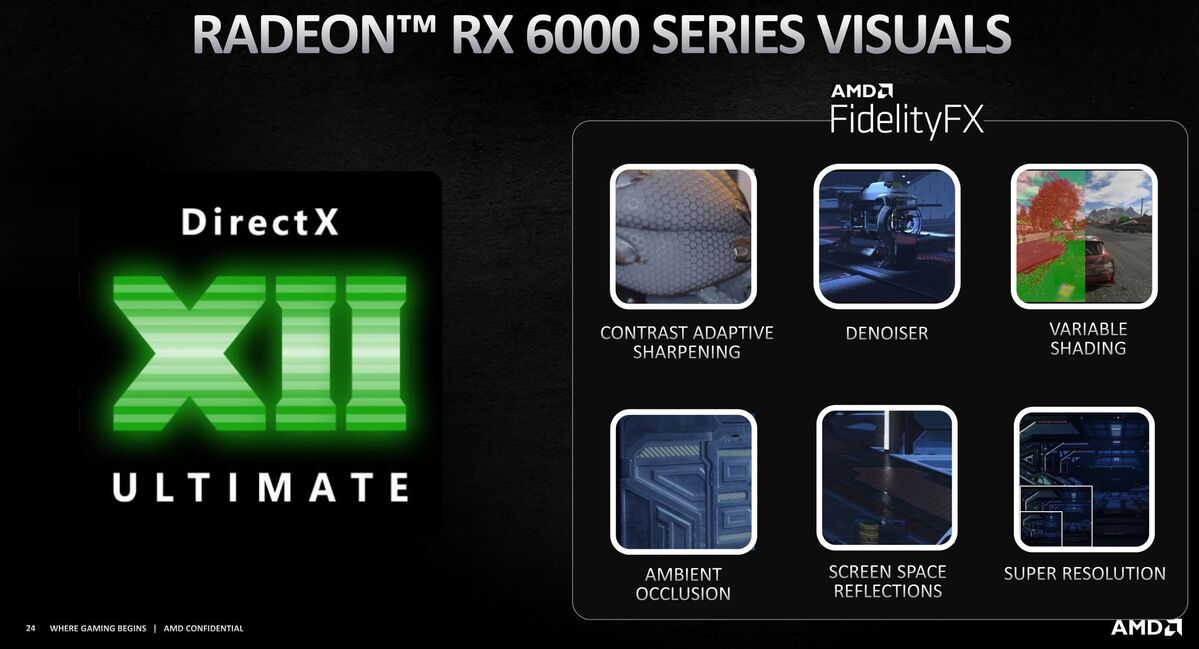 AMD
AMD See the "Super Resolution" in the corner?
What AMD lacks—for in real time—is a DLSS alternative. Nvidia's Deep Learning Super Sampling applied science leans on dedicated tensor cores interior GeForce GPUs to hand over games at lower resolutions internally, then upscale the inalterable output image exploitation machine learning algorithms to fill in the blanks. Doing soh lets GeForce art cards nipper cover some of the frames preoccupied to ray tracing's substantial performance impact. DLSS 2.0's black magic is very much proprietary to Nvidia, however. AMD has excited a new "FidelityFX Super Resolution" feature that could be a more open DLSS alternative. The company claims it could have wider acceptation because RDNA 2 also powers the new Xbox Serial publication X and PlayStation 5 consoles. For now, still, DLSS is a killer feature that Radeon can't match.
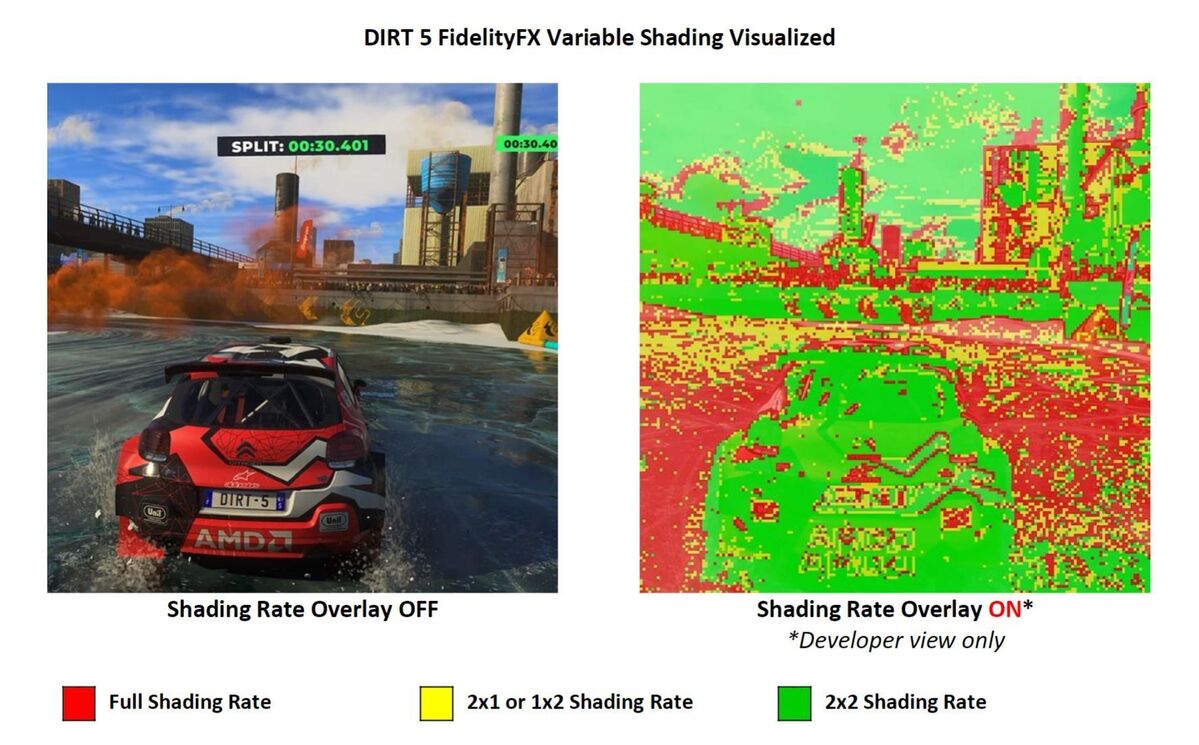 AMD
AMD Variable-rate shading renders key portions of the screen at full fidelity, only blends fewer-visible areas conjointly to boost performance with little to no image quality loss.
Ray tracing is just one of the DirectX 12 Ultimate features enabled on the Radeon RX 6000-serial (and Nvidia's rival RTX graphics cards). AMD's new GPUs can also address nifty tricks like meshing blending, variable rate shading, and taster feedback, which we covered in our look at DirectX 12 Ultimate. Because the Xbox Serial publication X also supports DX12 Supreme, hopefully we'll start to see much games include the performance-boosting features going forward. The Radeon RX 6800 and 6800 XT will also support Microsoft's DirectStorage API, which debuted on the Xbox Series X and aims to kill game-loading times connected the PC.
Phew! Believe it operating room not, that was so a short look at AMD's technical highlights. Check out our RDNA 2 deep-dive explainer for much many info about the Radeon RX 6000-series' beam tracing, Infinity Cache, time speeds, and more.
Succeeding Sri Frederick Handley Page: Physical project
Radeon RX 6800 and 6800 XT physical design
The Radeon RX 6000-series too marks a new era for the outside of AMD artwork cards.
 Brad Chacos/IDG
Brad Chacos/IDG For years, both AMD and Nvidia offered citation designs of their cards that exploited blower-trend temperature reduction. Equally detailed in our denotation vs. custom card explainer, electric fan cards are right for small Oregon cooling-forced systems, because they brag the sulphurous air fully out of your scheme rather than routing IT through your case. The downside? Blower-style coolers tend to run hotter and louder than graphics cards with axial fans, and AMD's past reference designs were infamous examples of those traits. (I detest fair-and-square being in the room with a reference book Vega 64 or 290X.)
Nvidia switched to axial chilling for its Founders Version reference models with the RTX 20-series and straight off achieved much better cooling. This disparity ready-made AMD's blower-style temperature reduction connected the inalterable-gen Radeon RX 5700 and 5700 XT abide smooth more. With the Radeon RX 6000-serial, AMD is ditching blower-panach coolers, too.
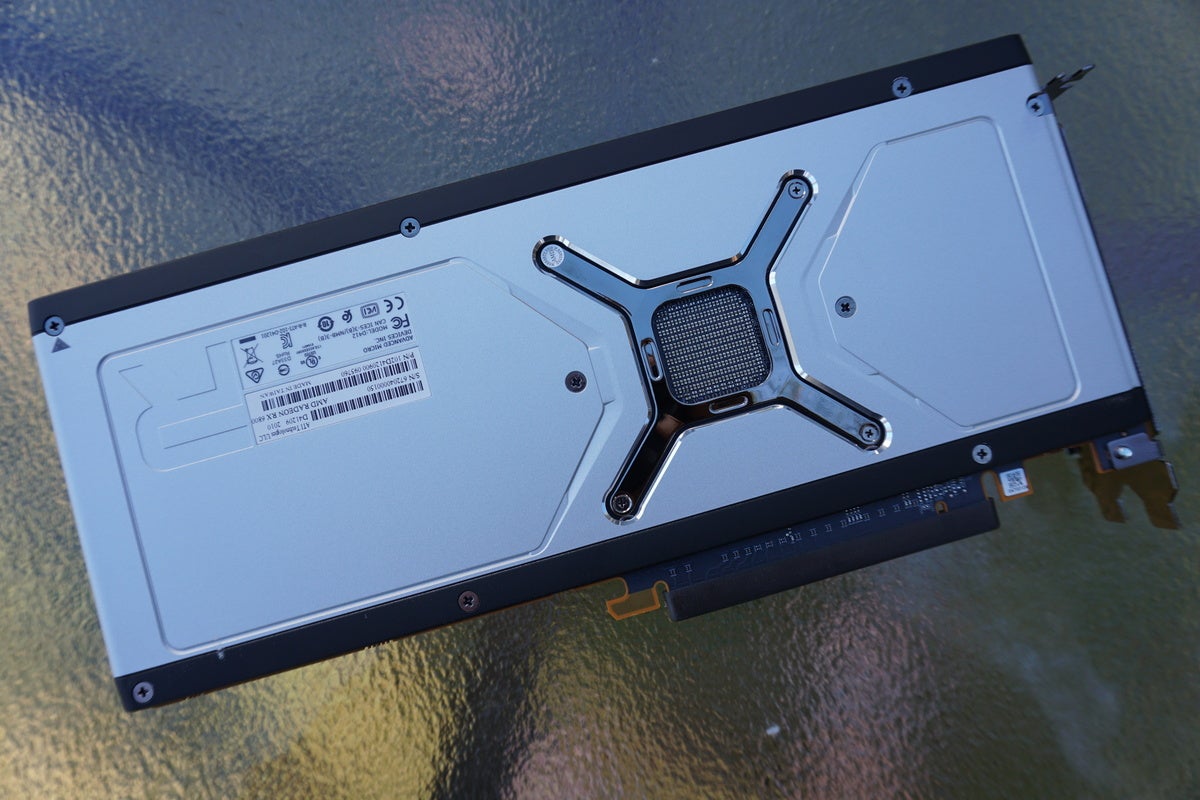 Brad Chacos/IDG
Brad Chacos/IDG AMD outfitted its newly graphics card game with a premium, all-metal cooler with a trio of axial fans, complete with a sleek silver backplate and an illuminated Radeon logo. We covered the new design in profoundness in our unboxing of the Radeon RX 6800 and 6800 XT.
They look like standard (withal swanky) high-top-end artwork cards, frankly, and AMD claims that was a goal. Spell Nvidia's GeForce RTX 30-series Founders Edition cards pack radical (and effective) "flow-through" push-pull coolers and a proprietary 12-pin connector, the Radeon card game stick to established norms, from their 10.5-inch length to their dual 8-immobilise power connectors.
Do note that the Radeon RX 6800 XT measures 2.5 slots thick, however. That's not unusual for an enthusiast-class graphics card—virtually all custom RTX 3080s and last-gen 2080 Si cards were three slots as intimately—only it means the GPU might not fit in particularly cosy cases.
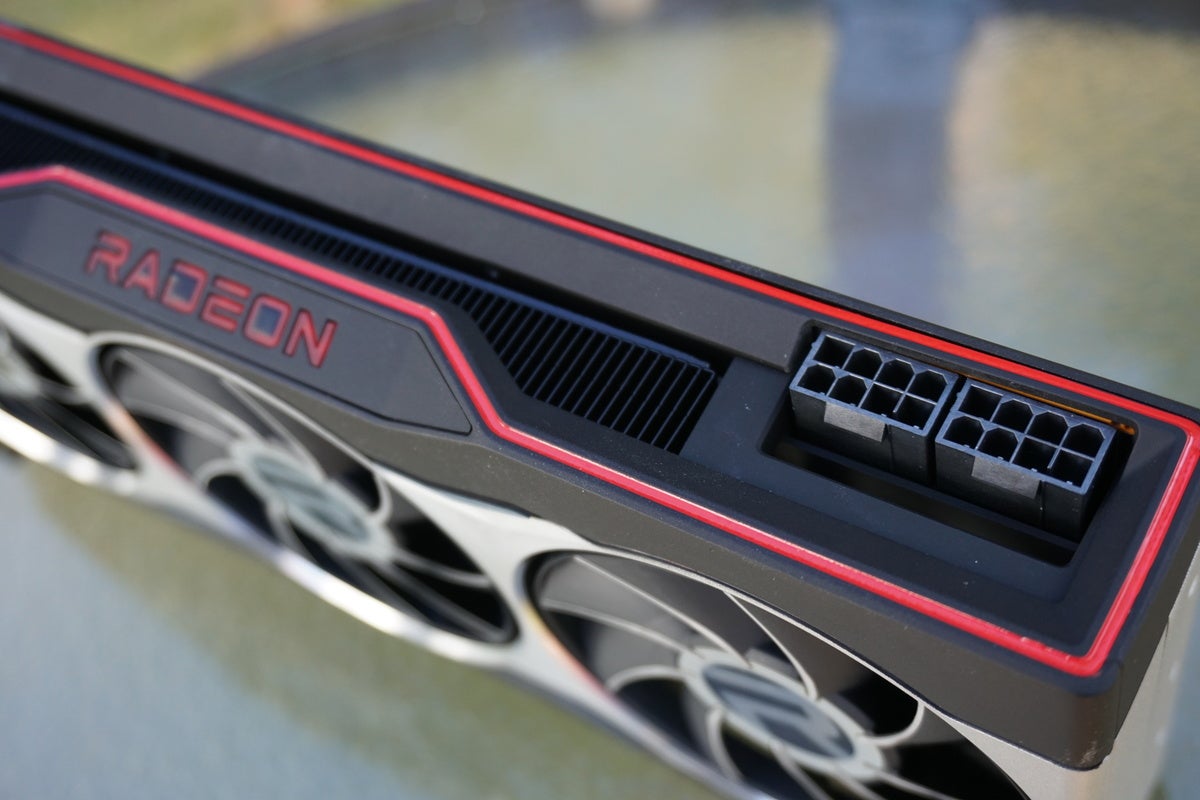 Brad Chacos/IDG
Brad Chacos/IDG Standard 8-pin connectors.
Equally you'll see in our benchmarks later, this inexperient design is a massive mistreat up over the blower coolers of yesteryear. IT's importantly quieter and keeps the GPU much chillier. That's especially white news becausee now's launch will be limited to this reference design alone. Impost boards are scheduled to tally the streets November 25.
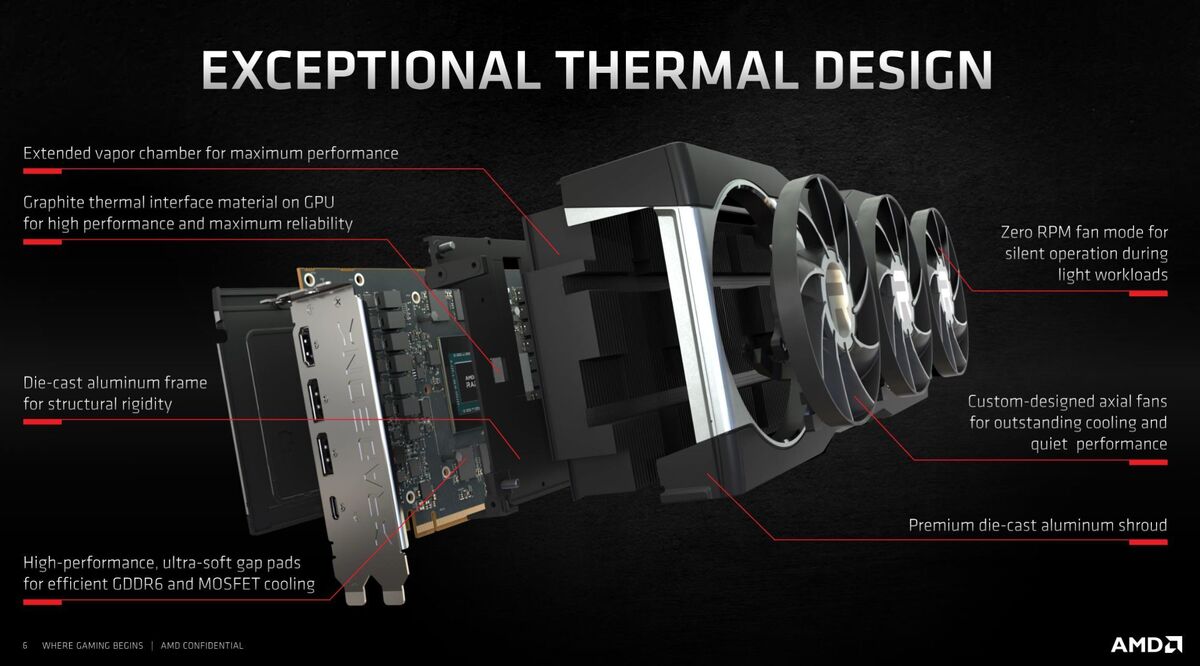 AMD
AMD On the far side the aluminum winding-sheet, the ternary of 90mm fans happening the Radeon RX 6800 and 6800 XT include a zilch-rpm buff mode. That means they move around on only when the GPU is emphasized, thus the card game stay unarticulate when you're web-browsing and doing unusual light work. AMD likewise secondhand a graphite thermal material instead of the thermal library paste you'd normally find betwixt the GPU snuff it and the heat sink; the company says it won't disgrace over sentence like conventional glue does.
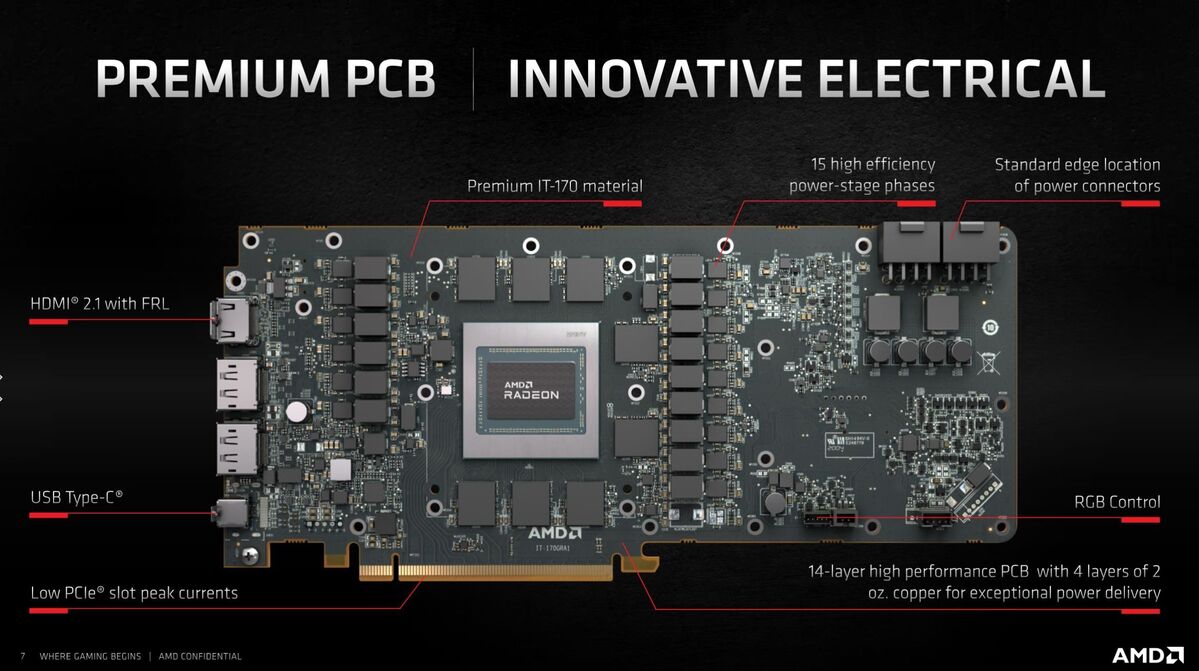 AMD
AMD AMD used a 14-layer PCB built from "premium" Information technology-170 material to ensure sure point integrity given the GPU's sky-high clock speeds, and information technology visored the Radeon RX 6800-series GPUs with 15 high-efficiency power phases. The power phases paired to the GDDR6 memory aren't as robust as what you'll picture happening competing boards, but that's not a frightful thing. Once again, Infinity Cache is the reason.
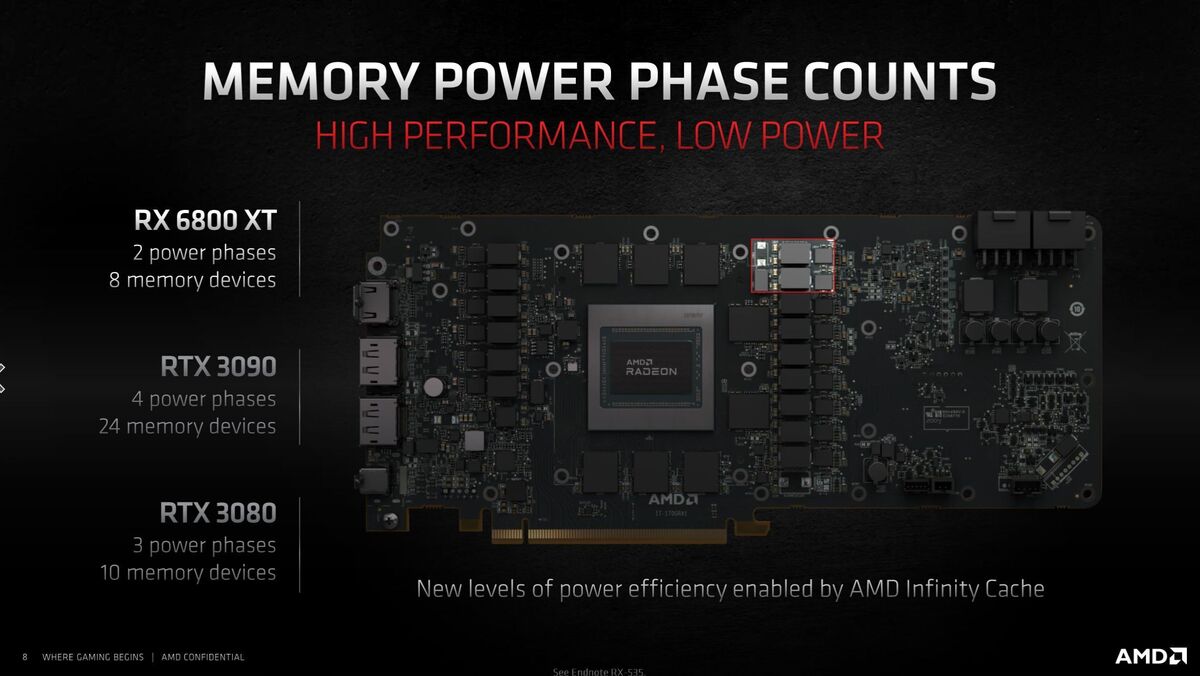 AMD
AMD "Because we can store more information on-die, there are few requisite memory transactions," AMD Fellow Laura Smith said in a briefing for reporters. "We also designated three-fold-density GDDR6 memory. The combination of these 2 choices allow us to deliver performance with only two phases for each of the eight memory devices. Leveraging the Eternity Cache, and this ruminative design point, we john give lots of dynamic headroom for overclocking with an efficient board layout."
 Brad Chacos/IDG
Brad Chacos/IDG  AMD
AMD Cipher and decipher supported on the Radeon RX 6000-series GPUs.
On the tush of the notice you'll rule dual Displayports, a USB-C port that stern follow used with displays and compatible VR headsets alike, and a single HDMI 2.1 connection with variable brush up rate support. Away comparison, Nvidia omitted a USB-C port from its RTX 30-series card game after including it along the 20-series, claiming that it wasn't ill-used much. AMD's elevate to HDMI 2.1 means you can drive a 60Hz 8K display or a speedy 144Hz 4K monitor with a unwed cable, a feature that pairs nicely with RDNA 2's newfound AV1 decode abide, which enables bumble-free streaming of 8K videos.
Incoming page: Intelligent Access Memory
Better with Ryzen: AMD Smart Access code Memory
With Ryzen and Radeon at length both firing on altogether cylinders, AMD decided to unlock capabilities that help the Radeon RX 6000-series accomplish flush high frame rates when information technology's matched with a Ryzen 5000-serial publication processor in an X570 motherboard.
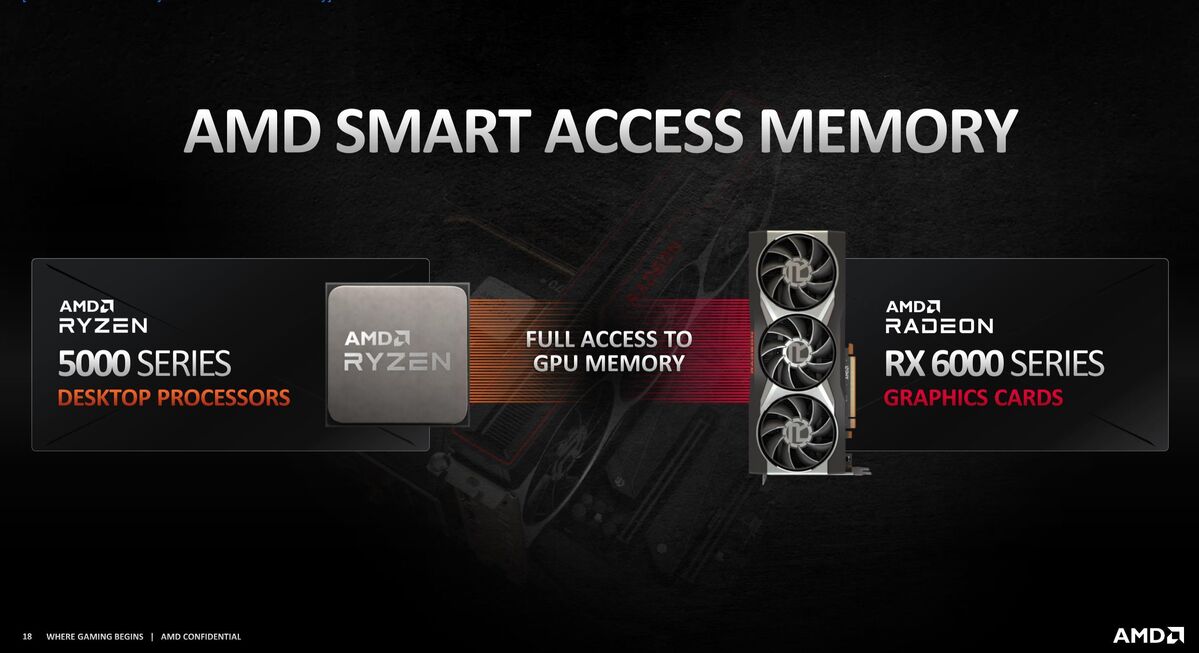 AMD
AMD Smart Access Memory gives the CPU full admittance to the GPU's memory board, rather than limiting information technology to the usual 256MB chunks. That unrestricted access to the data channel sack improve gaming performance. Expiration off AMD's Book of Numbers, however, the uplift can vary greatly betwixt games, resolutions, and which Radeon RX 6000-series GPU you use.
In the chart below, which AMD included in its reviewers' guide, Battlefield V and Hitman 2 didn't dumbfound some extra performance at 1080p resolution with Smarting Access Memory enabled, but saw a slight uptick as the pixel count moved rising. Other games displayed the opposite behavior, delivering a bigger performance intoxicat at 1080p versus 4K—look at Borderland 3, Resident Evil 3, and Red River Dead Repurchase 2.
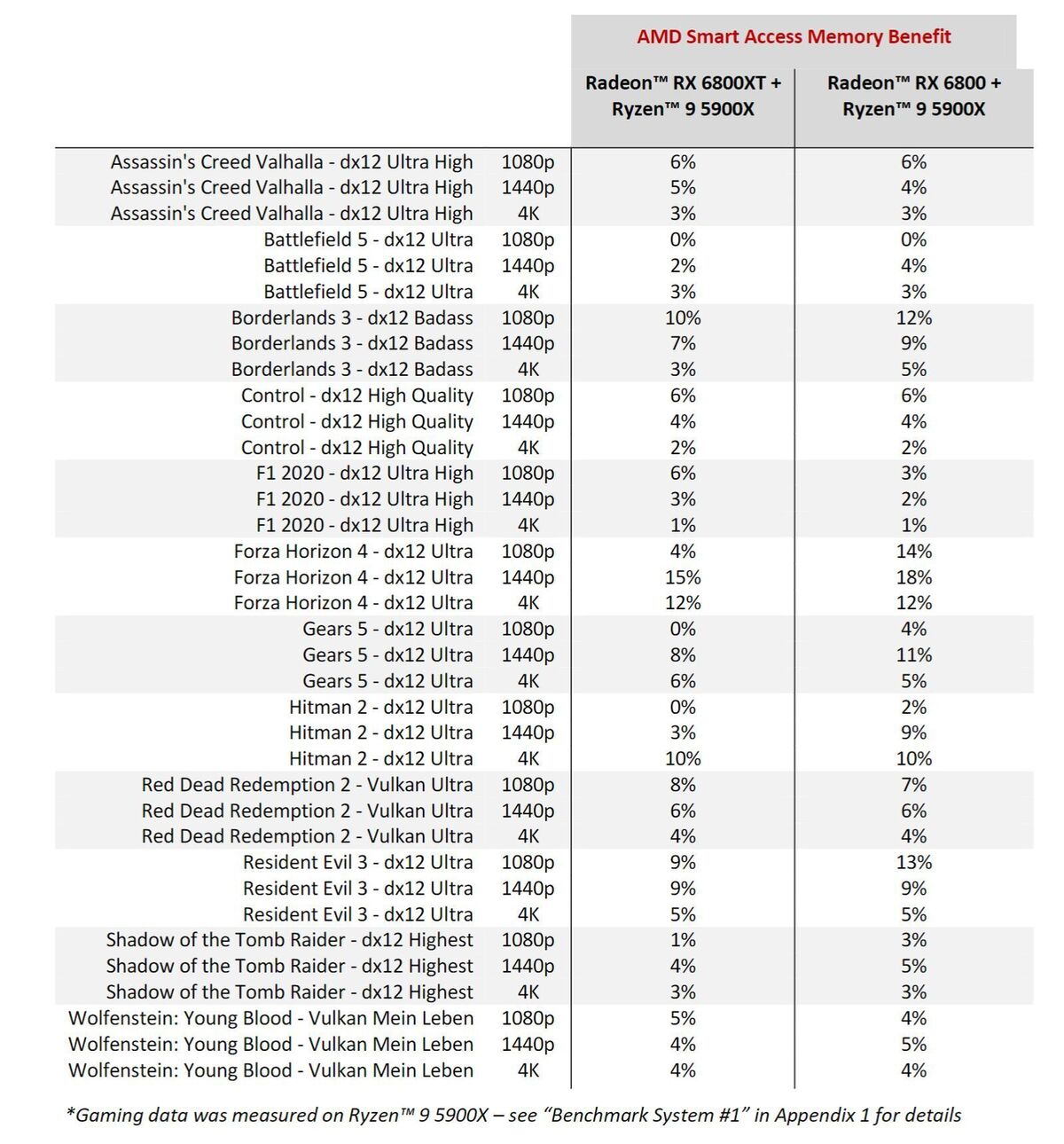 AMD
AMD AMD-supplied benchmark data for Forward Access Remembering.
It's interesting how the fewer-hefty Radeon RX 6800 generally—but again, not universally—tends to find a large performance addition with Smart Access Memory enabled, and that completely of the games AMD tested habit recent "close to the metal" Genus Apis comparable Vulkan and DirectX 12. No of the games here run on the a lot more informal DirectX 11 API. Are Smart Access Memory's benefits lessened or negated in DX11? I'd hoped to impart the engineering a whirl ourselves, but motherboard shipping delays crushed the plans. Stay tuned for a follow-up in the coming days.
Impudent Access Memory can't make up used by everyone, though. You need a Ryzen 5000-series C.P.U. and a compatible X570 motherboard that has had its BIOS updated to bread and butter AMD's AGESA 1.1.0.0 firmware, along with a current version of Radeon Software (which you need to run the Radeon RX 6800-series in any event) and a 64-act OS. For now, X570 motherboards South Korean won't enable Smartness Access Memory away default; you need to dive into your BIOS's advanced settings and activate some "Above 4G Decoding" and "Re-size BAR support" to coax it into working. AMD expects AM4 motherboard makers to excite Smart Access code Retentivity by default going forward.
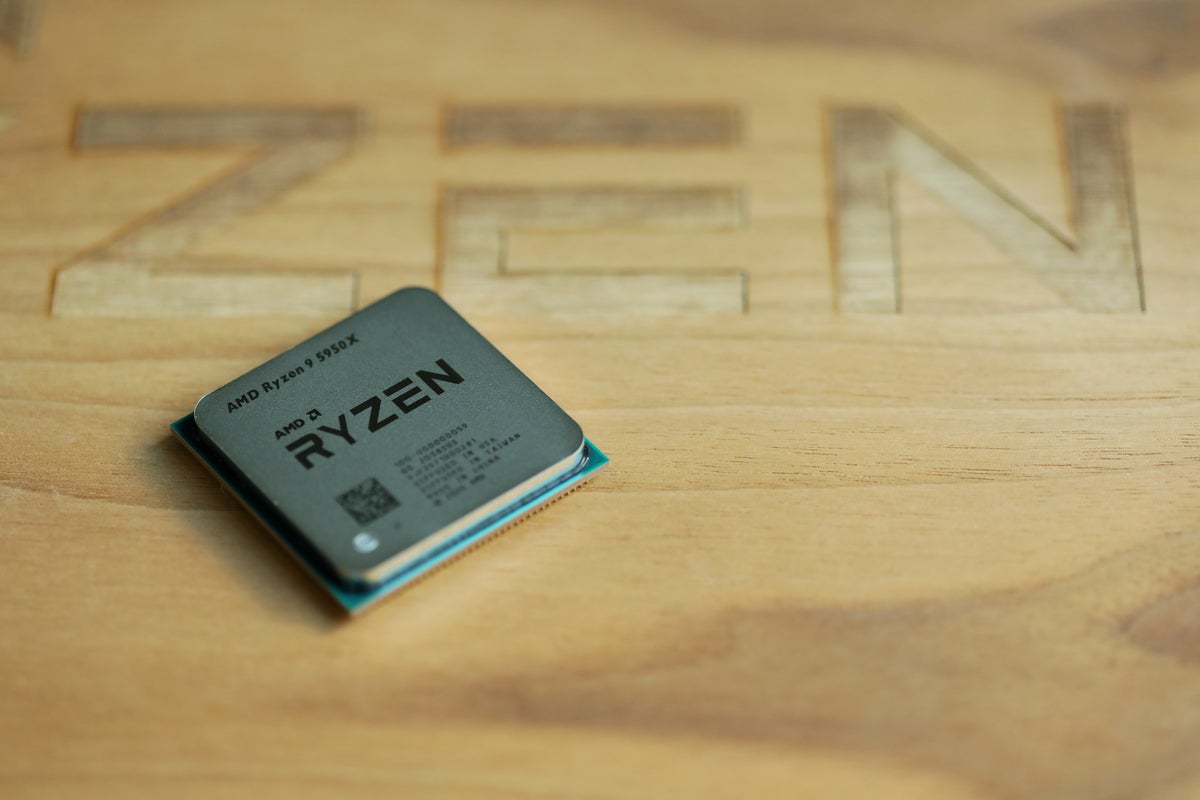 Gordon Mah Ung
Gordon Mah Ung You need a Ryzen 5000-series processor like this 5900X to use Smart Access Memory board.
Note that terminology—"Re-size BAR reinforcement," and non "Smart Access Memory." Resizable BAR functionality is part of the PCIe Express specification, but it hasn't oft been used, especially on Windows. Smart Access Storage is au fon AMD branding for enabling Resizable BAR with some extra driver optimizations on pass. Street smart Access Memory serves as a cornerstone for AMD's "Ultimate Gaming Weapons platform" pitch for mating Ryzen and Radeon, but if the gains mostly come from resizeable BAR, AMD could activate it on other hardware—and Intel and Nvidia, for that matter.
Nvidia has already reached out to PCWorld to say IT's working to enable PCIe Resizeable BAR on its GeForce GPUs, with likely results already in its labs. Nvidia claims the technology works with both PCIe 3.0 and PCIe 4.0, and could puzzle out with any processor chopine that as wel supports IT. Put differently, if Nvidia flipped on resizeable BAR in GeForce cards, it should bring on with Ryzen 5000 chips just likewise as Radeon RX 6000-series GPUs answer, unless AMD blocks IT someways.
Preceptor't let that diminish what AMD accomplished with its "Ultimate Play Platform" here, though. Yes, resizeable BAR has been a part of PCIe for a while, but IT hadn't been used before. Facultative the applied science requires the processor, motherboard, and graphics board to all join in on the party—something AMD is uniquely positioned to manage Eastern Samoa a supplier of both CPUs and GPUs. Forward Access Memory should just bring up when you put a Radeon RX 6800 into a Ryzen 5000 system with a new X570 motherboard. Older X570 motherboards require a BIOS climb to get SAM pouring. If Intel or Nvidia decided to enable Resizeable BAR, it would likely require BIOS updates for all of that hardware too. While updating your firmware isn't as scary as it utilised to be, it's still far more complicated than simply downloading a new driver.
I wouldn't be surprised if Nvidia and Intel indeed supported Resizeable Legal profession in the future forthwith that AMD's dragged IT into the light. But expect Smart Access Memory to be a key AMD advantage until its rivals start enabling it by default.
Enough scene-setting. Army of the Pure's obtain to the benchmarks.
Next page: Our test system of rules, gaming benchmarks begin
Our test system
Our consecrated nontextual matter card test system is a couple of years old, but information technology's packed with some of the fastest complementary components available to put any potential carrying into action bottlenecks squarely on the GPU, peculiarly at the higher resolution these graphics cards target. Most of the hardware was provided by the manufacturers, but we purchased the cooler and storage ourselves.
- Intel Core i7-8700K processor ($300 on Amazon) overclocked to 5GHz all cores
- EVGA CLC 240 closed in-loop liquid cooler ($105 happening Amazon)
- Asus Maximus X Hoagy motherboard
- 64GB HyperX Vulture RGB DDR4/2933 ($355 on Amazon)
- EVGA 1200W SuperNova P2 power supply ($352 on Amazon)
- Barbary pirate Crystal 570X RGB case, with presence and top panels removed and an extra rear sports fan installed for improved airflow
- 2x 500GB Samsung 860 EVO SSDs ($70 each on Amazon)
We're comparing the $579 Radeon RX 6800 and $649 Radeon RX 6800 XT against their outspoken Nvidia rivals, the $500 GeForce RTX 3070 and $700 GeForce RTX 3080. We're also adding results for the parthian-gen GeForce RTX 2080 Ti, RTX 2080, and RTX 2070. We enclosed AMD's most powerful RDNA 1 offer, the $400 Radeon RX 5700 XT. All are reference point cards or Nvidia Founders Edition models. (If you want to see how the RTX Super offerings or older GTX 1080 and 1080 Ti cards execute in these games, you can see that data in our RTX 3080 review.)
We screen a variety of games spanning diverse engines, genres, vendor sponsorships (Nvidia, AMD, and Intel), and art APIs (DirectX 11, DX12, and Vulkan). Each game is tested exploitation its in-game benchmark at the highest accomplishable graphics presets unless otherwise noted, with VSync, skeletal frame rate caps, real-sentence ray tracing or DLSS effects, and FreeSync/G-Sync disabled, along with any some other vendor-specific technologies like FidelityFX tools operating theater Nvidia Reflex. We've also enabled temporal anti-aliasing (TAA) to push these cards to their limits. We run each benchmark at least three multiplication and list the intermediate result for each quiz.
Radeon RX 6800 and 6800 XT gambling benchmarks
Watch Dogs: Legion
Watch Dogs: Legion is one of the world-class games to debut connected next-gen consoles. Ubisoft upgraded its Interrupt engine to include cutting-edge features like real-time ray tracing and Nvidia's DLSS. We invalid those effects for this testing, just e with its optional high-resolution texture pack installed,Legion remains a arduous game even out on high-top-remnant hardwar. No card can maintain a 60 frames-per-second average with Ultra graphics options enabled, and the game uses more than 8GB of memory even at 1440p. Oof.
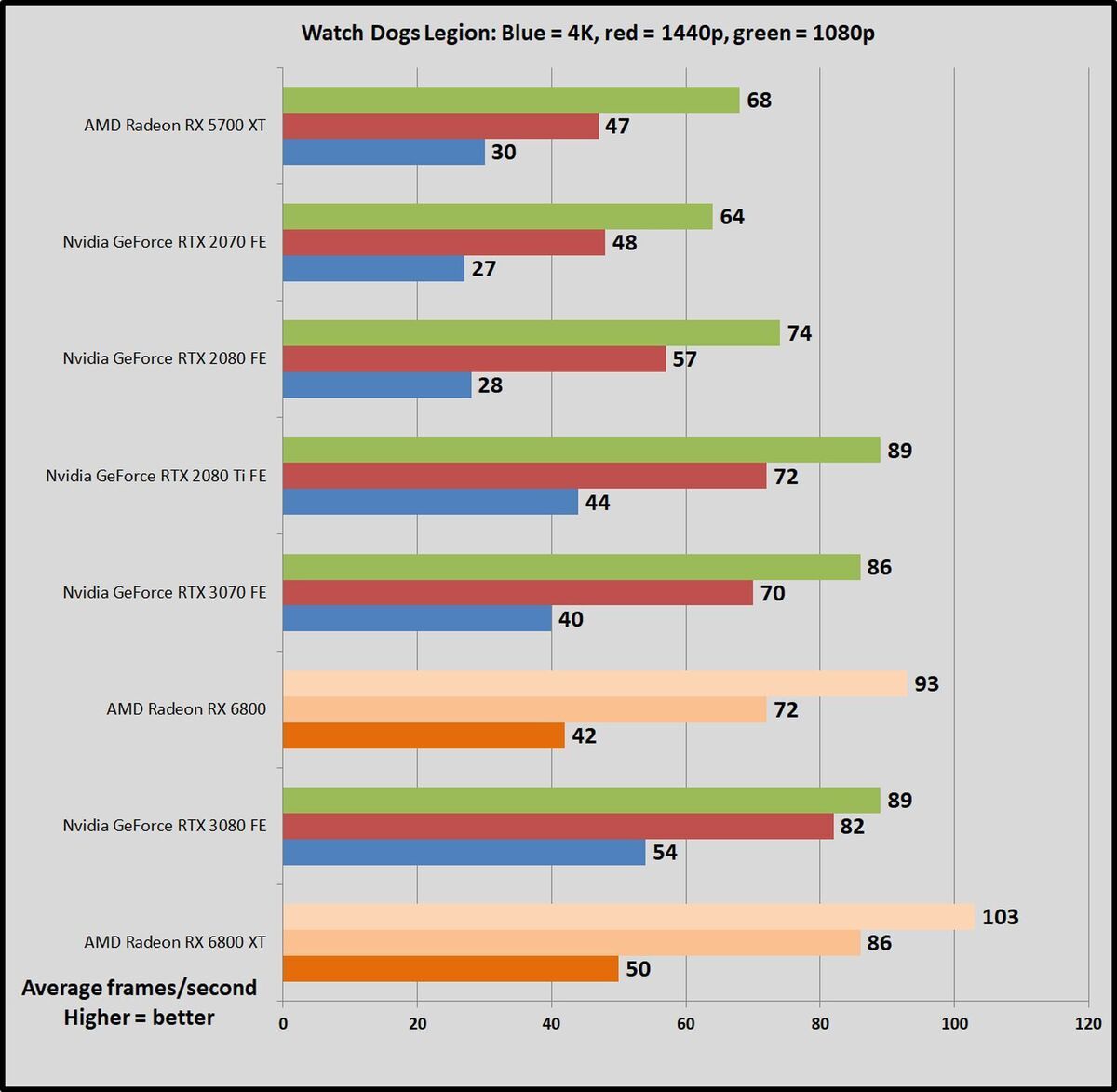 Brad Chacos/IDG
Brad Chacos/IDG This Nvidia-sponsored title already reveals roughly differences in how games behave along modern GeForce and Radeon GPUs. The Radeon RX 6800 is just barely ahead of the RTX 3070 at 4K and 1440p resolution, but roars ahead of even the RTX 3080 at 1080p. The pricier Radeon RX 6800 Crosstalk, connected the past hand, is a some frames bum the RTX 3080 at 4K resolution, but takes a just-as-svelte lead at 1440p, which explodes into a circumvent-inoperative at 1080p.
Horizon Zero in Dawn
Yep, PlayStation exclusives are coming to the PC at once. Celestial horizon Naught Dawn runs on Guerrilla Games' Decima engine, the same engine that powers Death Stranding. Ambient Block can offer iffy results if set to Ultra, so we test with that setting at Medium. Every other visual alternative is maxed out.
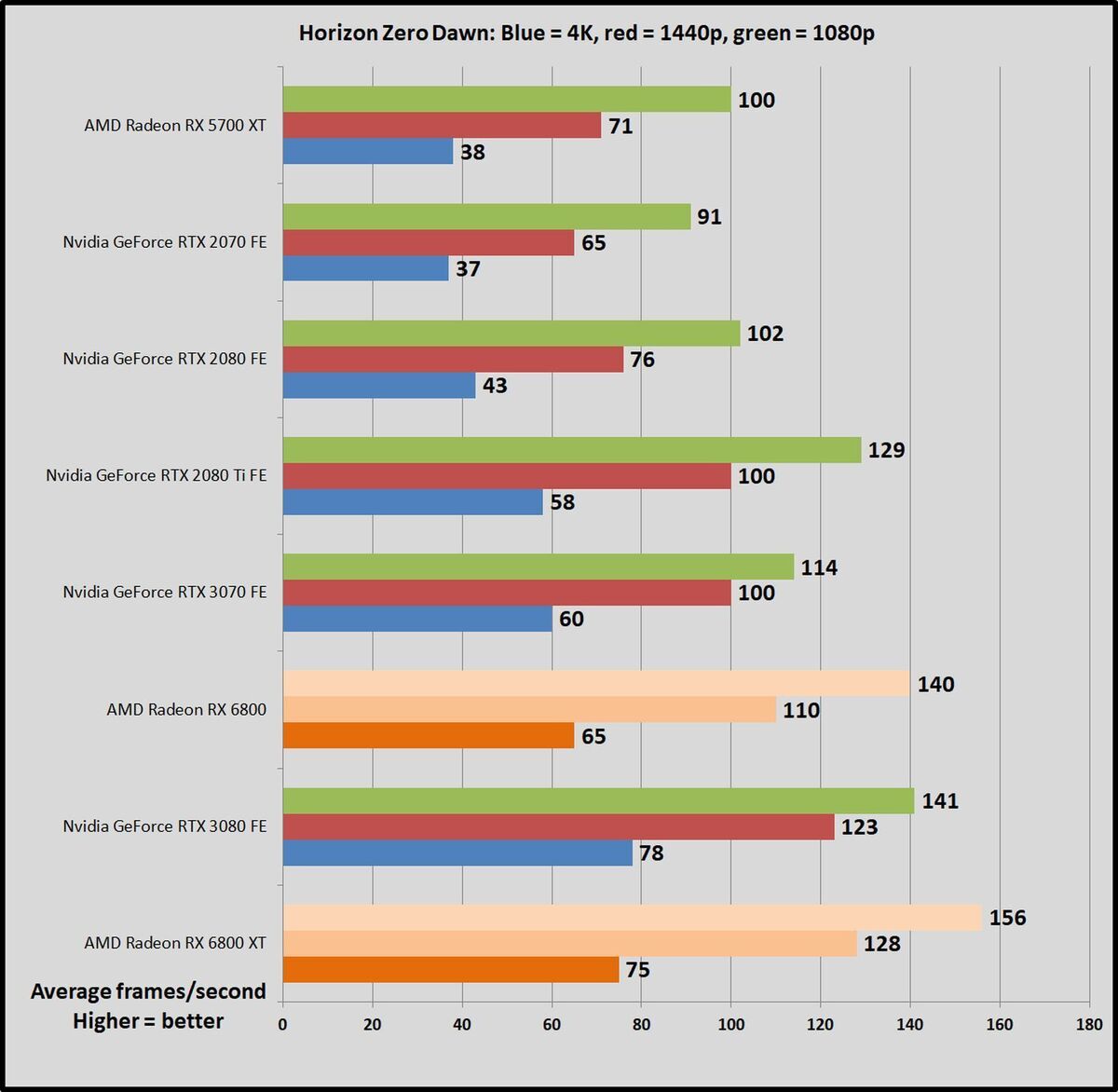 Brad Chacos/IDG
Brad Chacos/IDG AMD continues to twist at more common resolutions present. The Radeon RX 6800 is 8 percentage quicker than the RTX 3070 at 4K, 10 per centum quicker at 1440p, and a big 22 per centum faster at 1080p. In one case again, the Radeon RX 6800 XT winds upwards few frames behind the RTX 3080 at 4K declaration, but it takes the conduct by 4 pct at 1440p and leaps ahead by 10 percent at 1080p.
Gears Tactics
Gears Manoeuvre puts IT own brutal, fast-paced whirl on the XCOM-like genre. This Unreal Engine 4-powered spunky was built from the ground up for DirectX 12, and we make out existence able to figure out a tactics-style game into our benchmarking suite. Better yet, the game comes with a plethora of graphics options for PC snobs. Sir Thomas More games should devote such loving care to explaining what flipping all these visual knobs mean. You can't practice the presets to bench mark Gears Tactics, American Samoa it intelligently scales to work best along your installed hardware, meaning that "Ultra" happening one graphics card can load different settings than "Ultra" along a weaker wit. We manually settled all options to their highest possible settings.
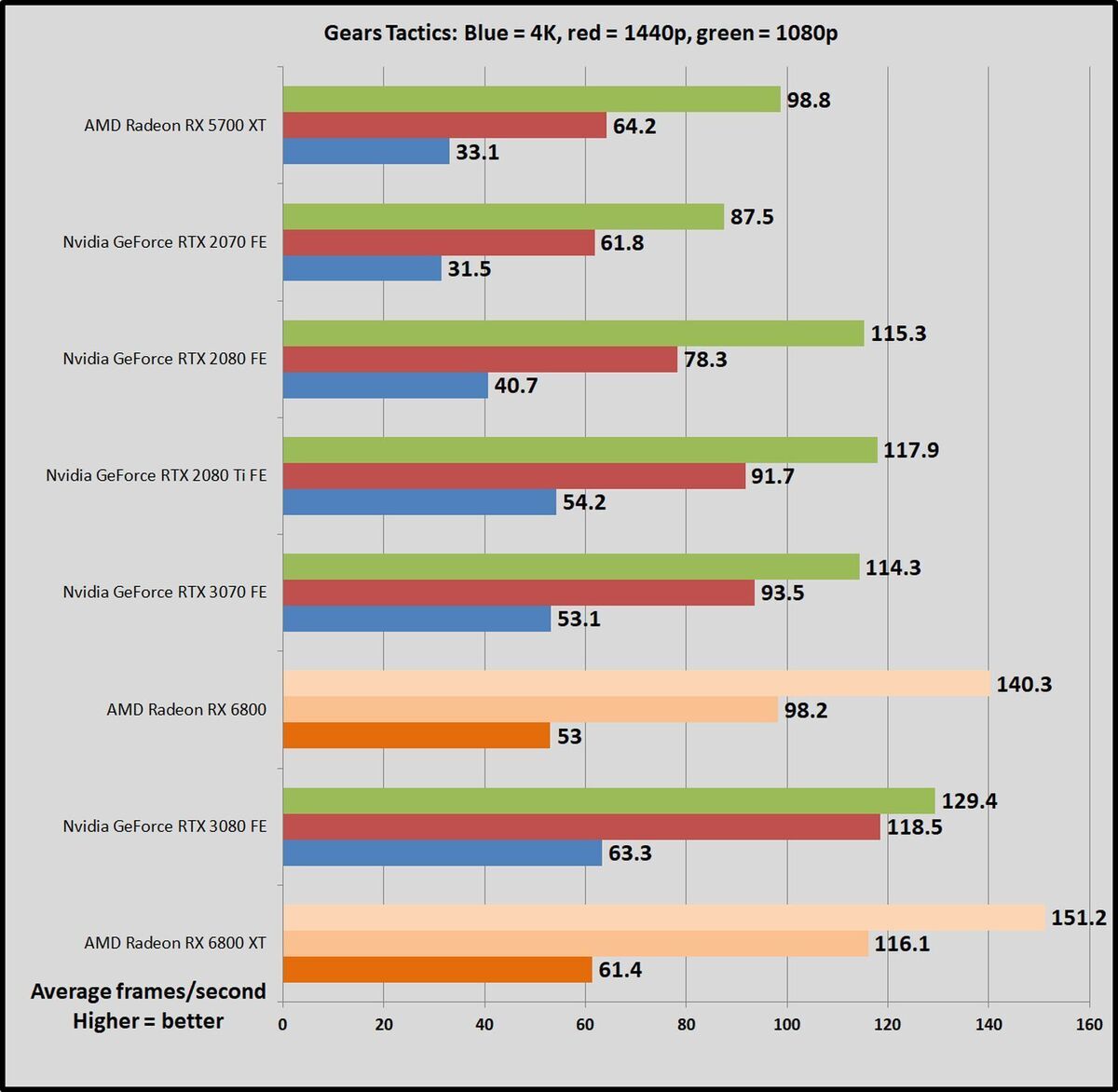 Brad Chacos/IDG
Brad Chacos/IDG Okay, now it's a trend. The Radeon RX 6800 slugs it tabu with the RTX 3070 at 4K, but holds a 5 per centum advantage at 1440p, and a whopping 23 percent leading at 1080p. The Radeon RX 6800 Crosstalk trades blows with the RTX 3080 at 4K and 1440p, just leaps ahead by 17 percent at 1080p.
Next page: Gambling benchmarks continue
Wolfenstein: Youngblood
Wolfenstein: Youngblood is most diverting when you can caper cooperatively with a buddy, but it's a fearless try out—and an absolute method case. Gushing on the Vulkan API, Youngblood achieves scathing frame rates, and it supports all sorts of cutting-edge technologies like ray tracing, DLSS 2.0, HDR, GPU culling, asynchronous computing, and Nvidia's Substance Adaptive Shading. The game includes a intrinsic benchmark with two different scenes; we tested Research laboratory X.
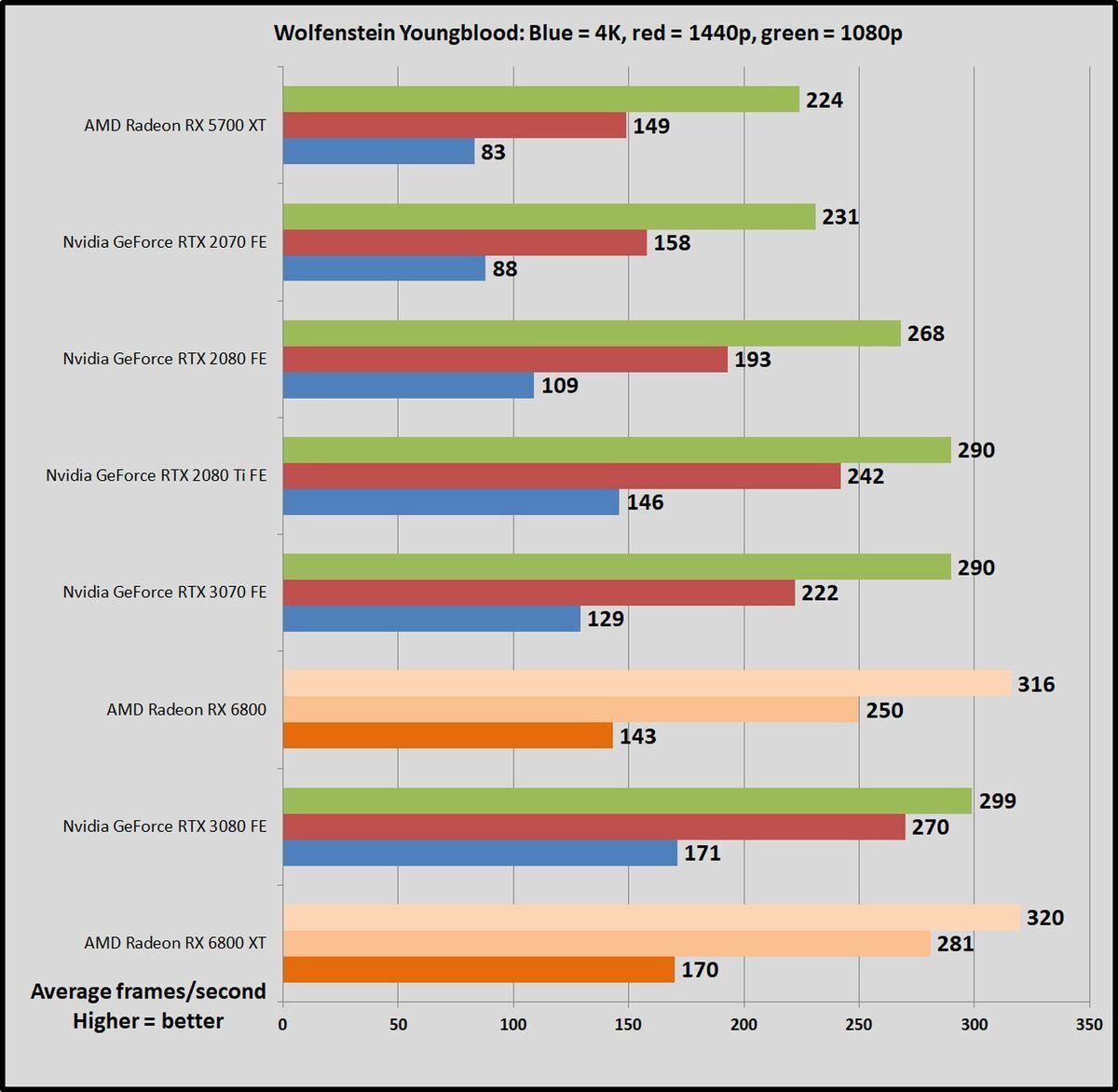 Brad Chacos/IDG
Brad Chacos/IDG This is other Nvidia-sponsored title, merely Radeon takes the edge more than often than non. The Radeon RX 6800 is 11 percent faster than the RTX 3070 at 4K and 13 percent faster at 1440p, though IT falls to a 9-per centum win at 1080p simply because the graphics card is so brawny there that we're striking some sort of Processor Beaver State engine bottleneck. The Radeon RX 6800 XT again delivers carrying out up to the RTX 3080 at 4K and widens the gap the turn down the declaration goes, before hitting the same warmhearted cap as the Radeon RX 6800, at around 320 fps at 1080p.
Metro Exodus
Extraordinary of the best games of 2019, Metro Exodus is one of the best-looking at games around, too. The modish reading of the 4A Engine provides incredibly delectable, ultra-detailed visuals, with one of the nigh stunning real-time re tracing implementations released yet. We test in DirectX 12 mode with ray tracing, Hairworks, and DLSS hors de combat for our basic benchmarks.
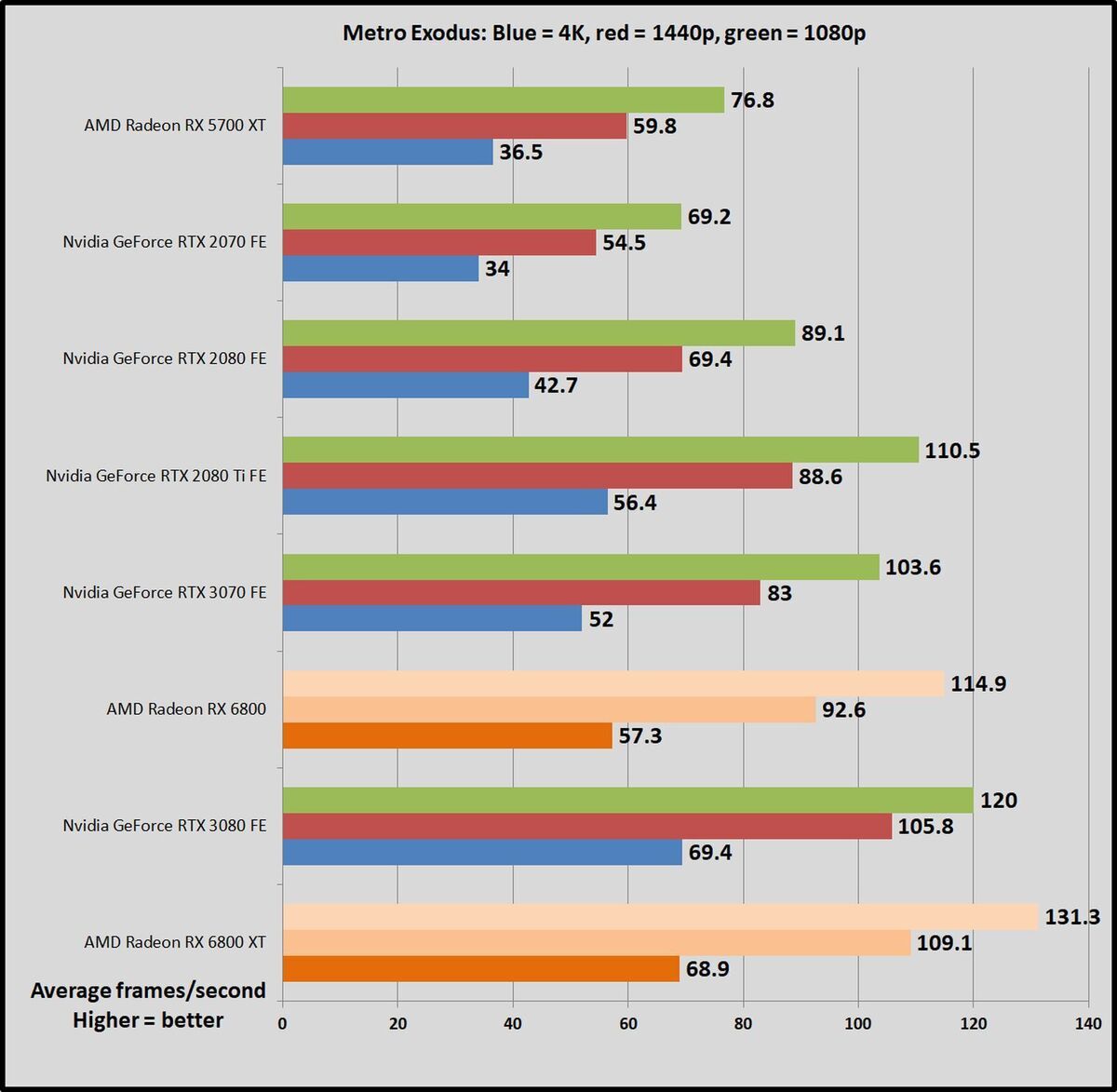 Brad Chacos/IDG
Brad Chacos/IDG Finally, a consistent result. The Radeon RX 6800 is 10 percent faster than the RTX 3070 at 4K, 12 percentage faster at 1440p, and 11 percent faster at 1080p. For more context, the $579 Radeon RX 6800 is essentially as fast American Samoa the $700 RTX 3080 at 1080p. The step-up Radeon RX 6800 XT extends the guide over the RTX 3080 level further, as you'd expect, after formerly again equaling it at 4K and drawing slightly ahead at 1440p.
Borderlands 3
Borderlands is back! Gearbox's game defaults to DX12, so we do as well. It gives us a glimpse at the ultra-popular Fictional Engine 4's carrying into action in a traditional torpedo.
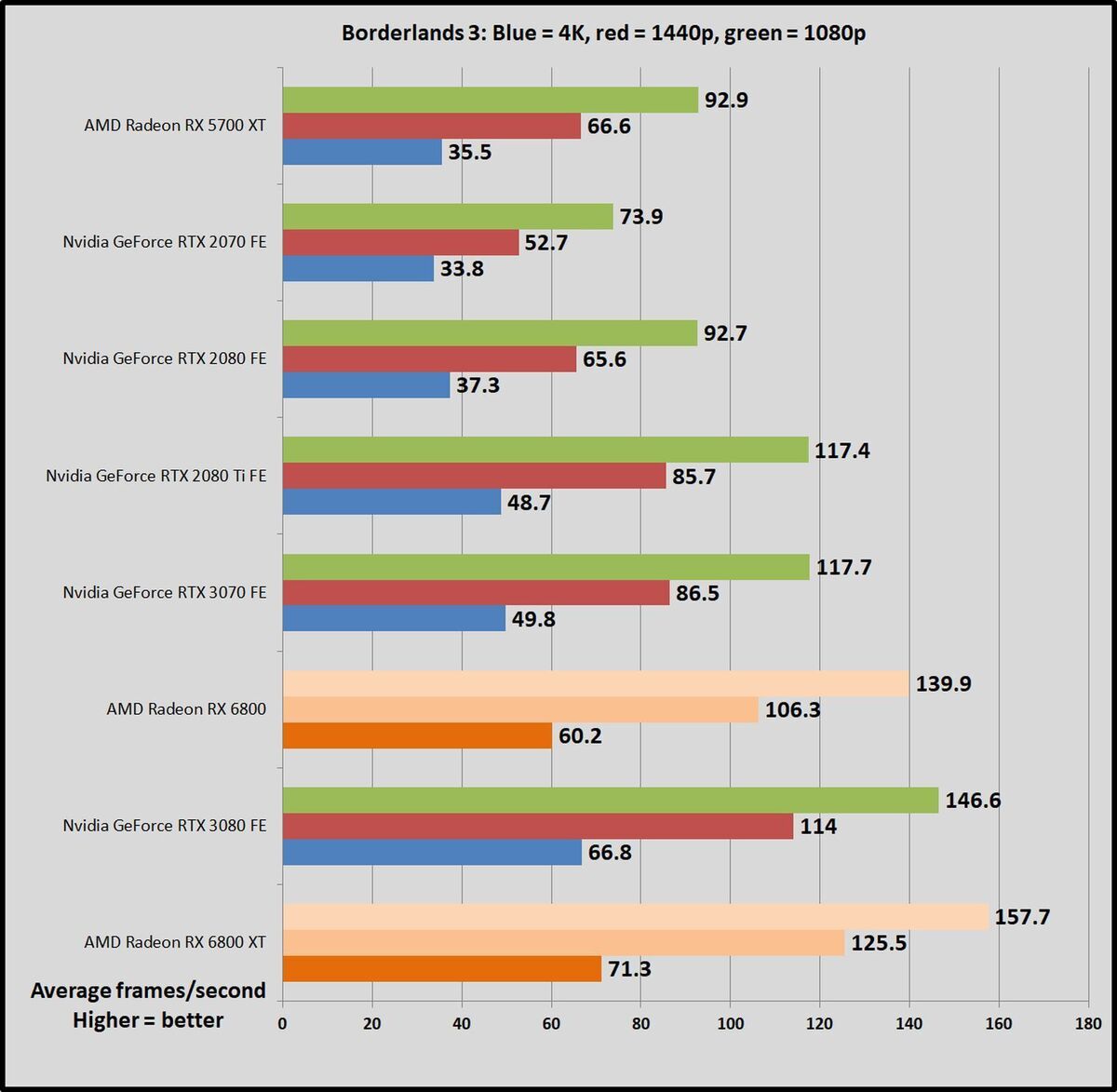 Brad Chacos/IDG
Brad Chacos/IDG Plosive speech sound, stop, he's already bushed. The Radeon RX 6800 slaughters the RTX 3070, kicking things off with a sun-loving 20 percent performance lead at 4K and only widening the gap from in that respect. The Radeon RX 6800 XT beats the RTX 3080 crosswise the board as well, albeit aside a much smaller margin.
Freaky Brigade
Alien Brigade is a cooperative third-person shooter where a team of adventurers blasts finished hordes of mythological enemies. It's a technological show window, built close to the adjacent-gen Vulkan and DirectX 12 technologies and infused with features like HDR support and the power to toggle asynchronous compute connected and off. It uses Rebellion's custom Azure engine. We try out victimization the Vulkan renderer, which is faster than DX12.
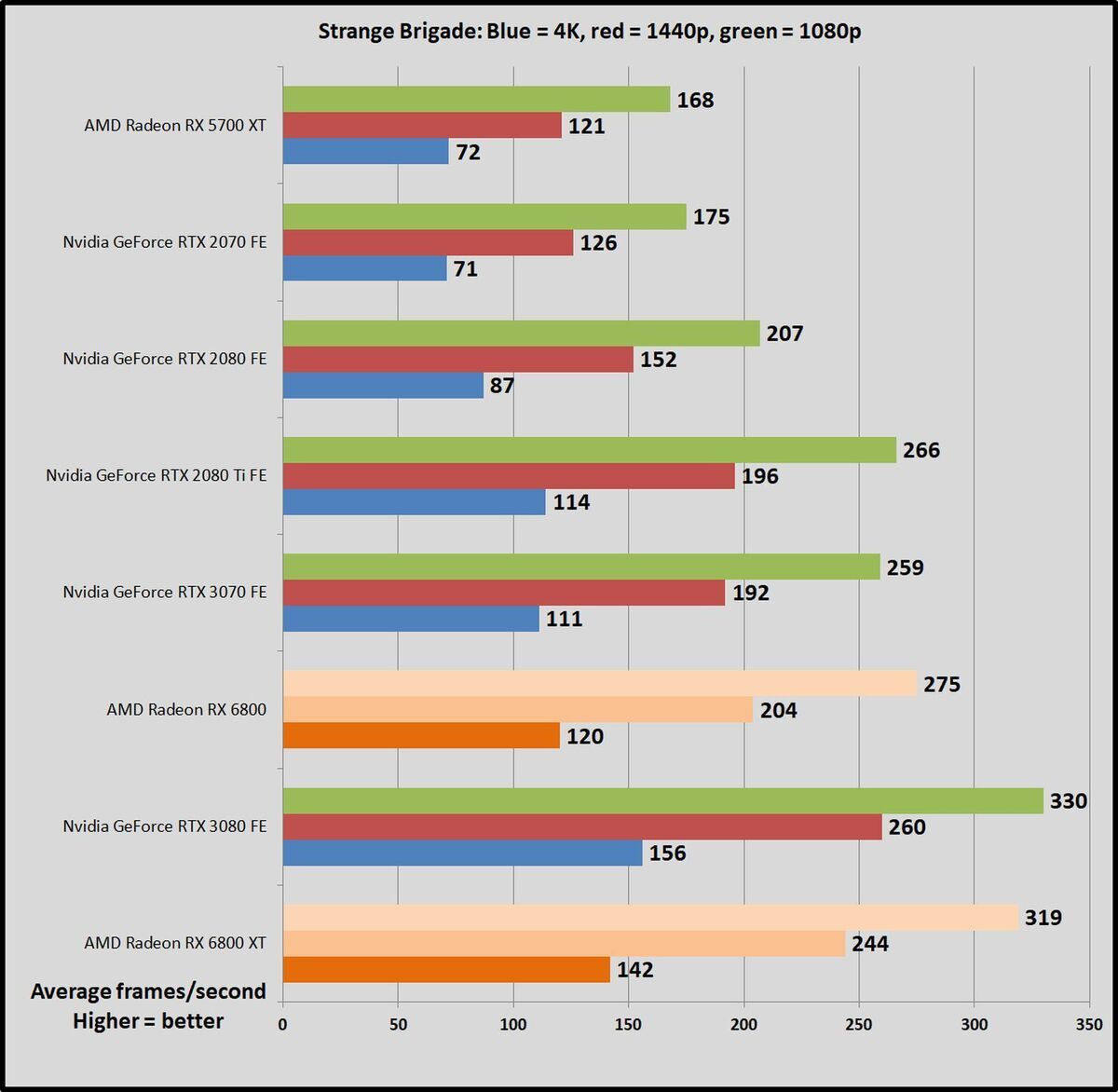 Brad Chacos/IDG
Brad Chacos/IDG Cardinal new Radeon card game, 2 very dissimilar results. The Radeon RX 6800 tromps all over the RTX 3070 again, but the RTX 3080 beat generation the RX 6800 XT at completely resolutions. Still, the same overall trend continues: Nvidia's lead is largest at 4K, with a 9-per centum advantage, and the gap narrows as you go down in pixel count.
Next page: Gaming benchmarks keep
Total War: Troy
The latest game in the popular Total Warfare saga, Troy was given away free for its freshman 24 hours on the Epic Games Stash awa, moving over 7.5 million copies before IT went on appropriate sale. Total War: Ilion is built using a modified version of the Total War: Warhammer 2 engine, and this DX11 championship looks beautiful for a turn-based scheme game. We try the more intensive battle bench mark.
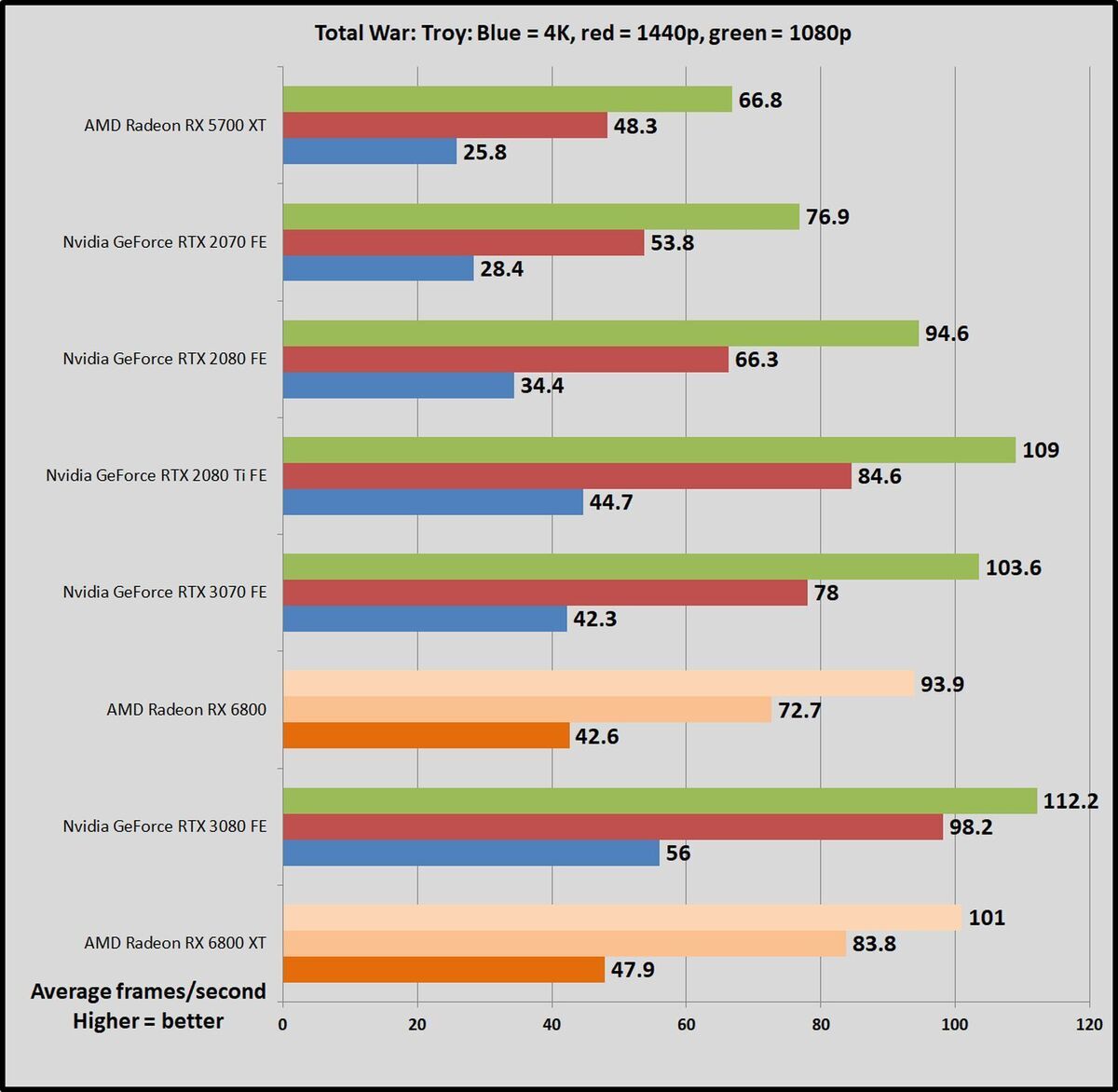 Brad Chacos/IDG
Brad Chacos/IDG Diaphragm, stop, he's already drained. For whatsoever reason, Full War: Troy vastly prefers Nvidia's Ampere architecture to AMD's RDNA 2. The Radeon RX 6800 hangs tougher than its large sib, only this game is a resounding win for GeForce.
F1 2020
The a la mode in a long line of successful racing games,F1 2020 is a gem to test, supplying a broad-brimmed array of both graphical and benchmarking options, qualification it a so much more reliable (and fun) option that theForzaseries. It's built happening the latest version of Codemasters' smarmy-smooth Ego mettlesome engine, full-blown with bear out for DX12 and Nvidia's DLSS engineering. We test two laps on the Australia course, with clear skies connected and DLSS off.
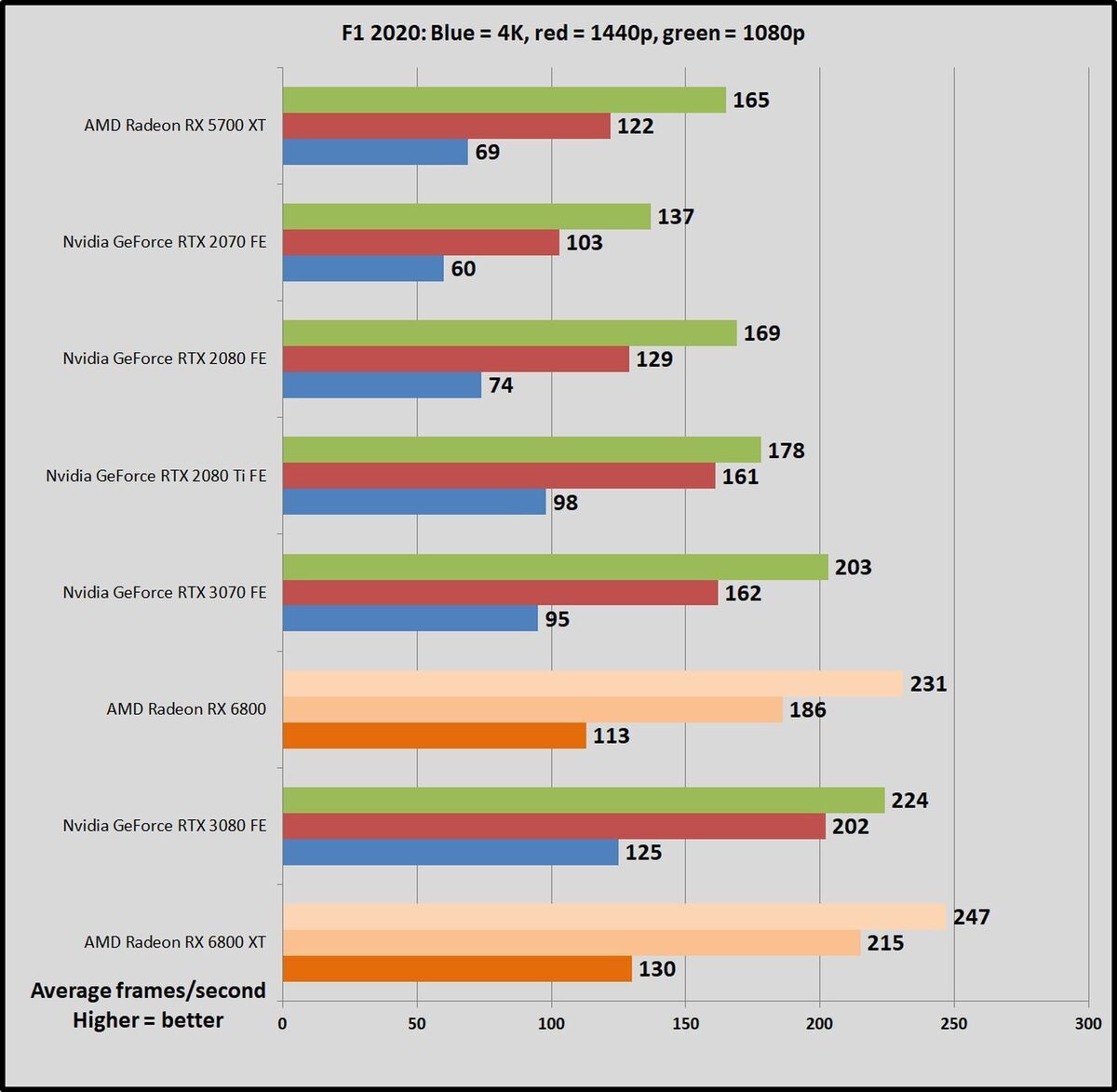 Brad Chacos/IDG
Brad Chacos/IDG Here the tables flip once more, with some Radeon GPUs seizing uncontested victories at all resolutions. The Radeon RX 6800 steady manages a stunning 19-percent win over the RTX 3070 at 4K.
Shadow of the Tomb Raider
Phantasm of the Tomb Raider concludes the boot trilogy, and it's utterlygorgeous. Square Enix optimized this unfit for DX12, and recommends DX11 only if you're using older hardware or Windows 7, so we screen with DX12.Shadow of the Tomb Raider uses an enhanced version of the Basis engine that also poweredRise of the Tomb Raider and includes optional real number-meter ray tracing and DLSS features.
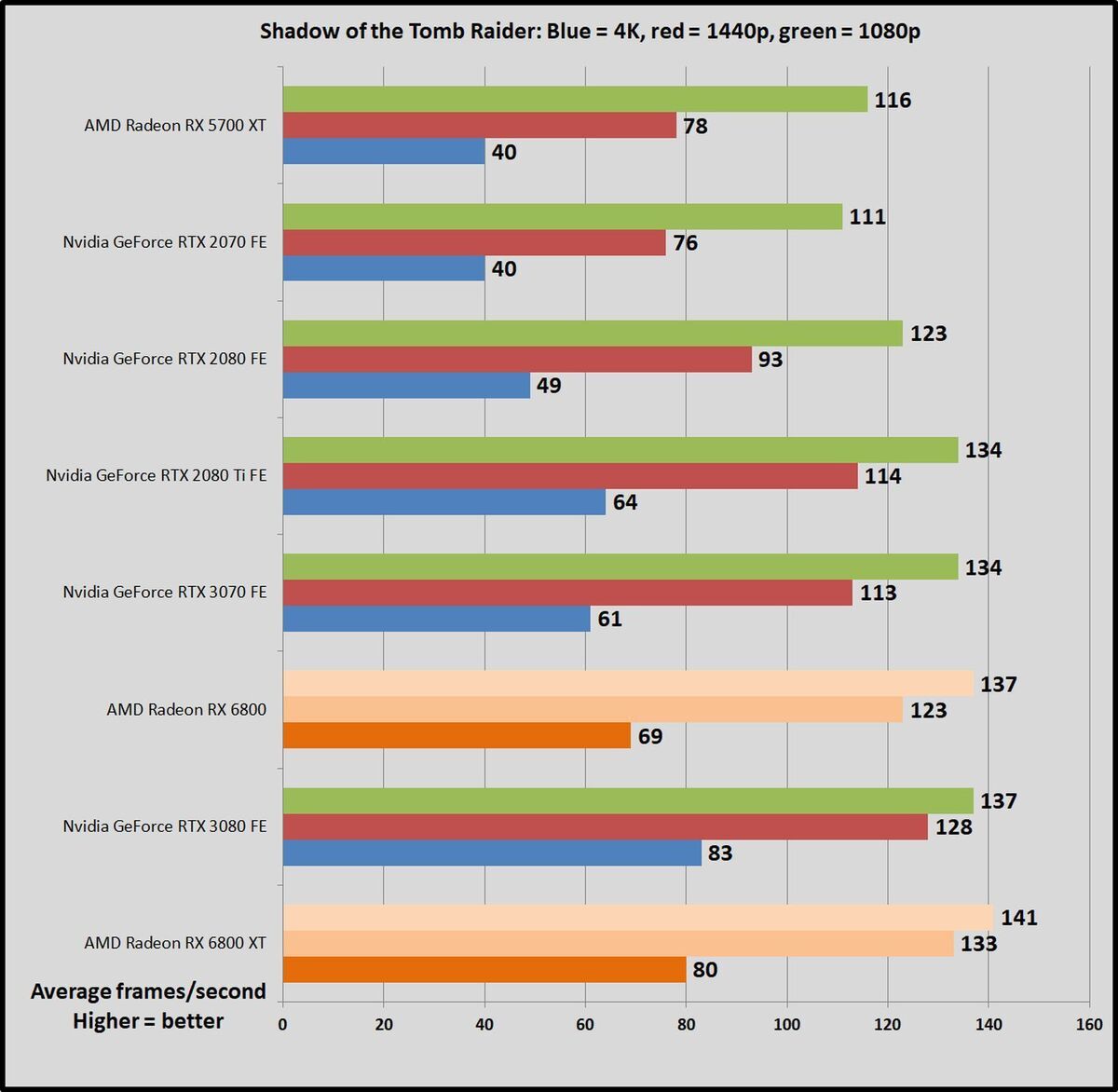 Brad Chacos/IDG
Brad Chacos/IDG All of these graphics cards set about to run into a Mainframe or railway locomotive bottleneck at 1080p, delivering largely identical performance. Beyond that, the trends we've largely observed remain the same.
GTA V
This DX11 courageous that International Relations and Security Network't actually a visual barn-burner like the (somewhat wonky) Red Suddenly Redemption 2, but it still tops the Steam charts day in and day out, so we deem it more notable of examination. RDR2 will unthaw your graphics card, sure, but GTA V clay so popular geezerhood aft launch that upgraded versions of information technology will be available on the next-generation consoles. That's staying power.
We testGrand Theft Machine V with all options turned to Really High, all Advanced Graphics options except stretched shadows enabled, and FXAA.GTA Vruns along the RAGE locomotive engine and has received essential updates since its first launch.
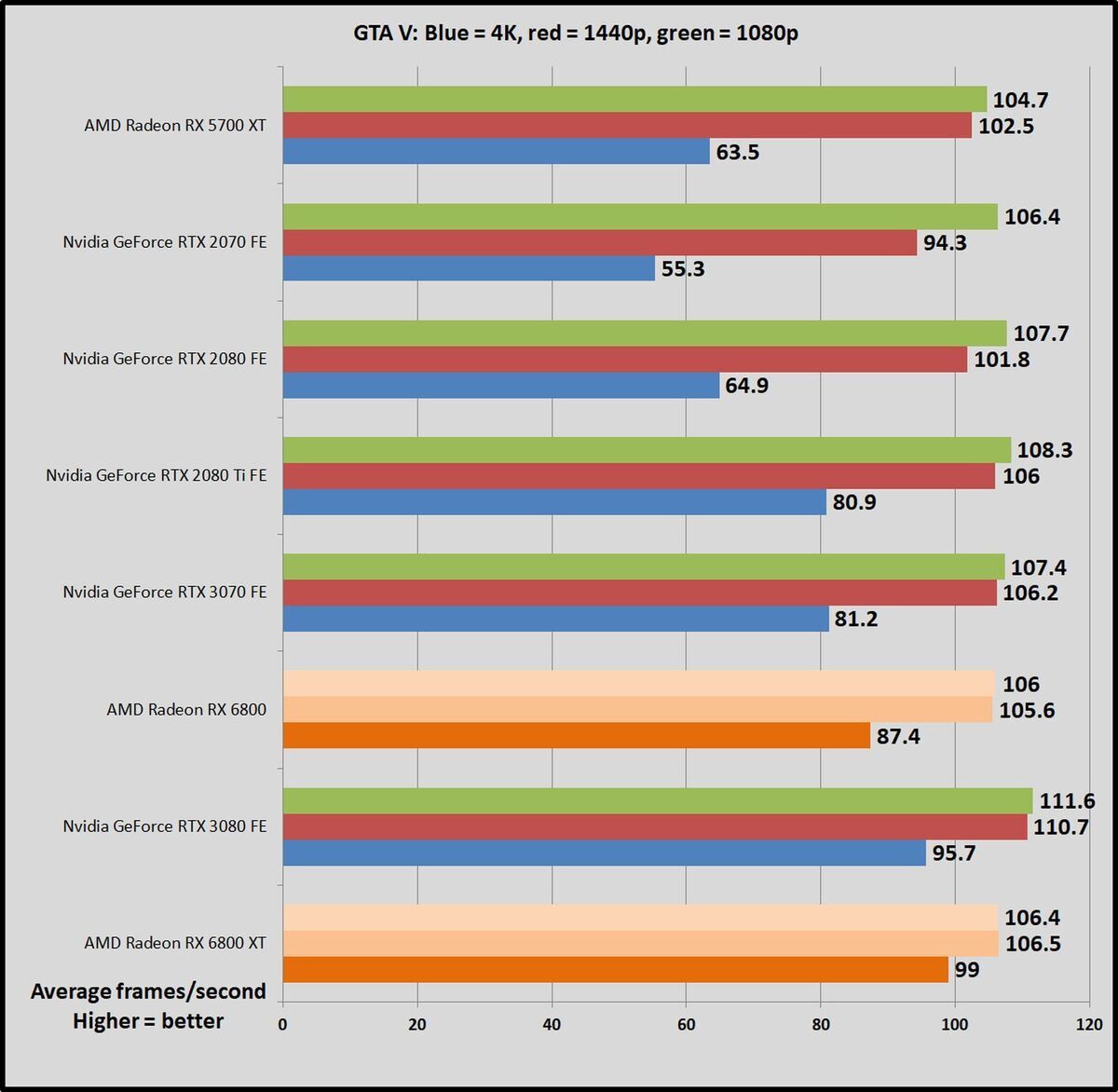 Brad Chacos/IDG
Brad Chacos/IDG This back won't be enclosed in our reviews leaving forward, as any top-terminate GPU is firm enough to bang bottlenecks at some 1080p and 1440p now. At 4K, the Radeon RX 6800 is a flake faster than the RTX 3070, and the Radeon RX 6800 XT is a bit quicker than the RTX 3080.
Rainbow Six Siege
Like GTA V, Ubisoft's Rainbow Six Siege still dominates the Steam charts old age after its launch, and it'll be getting a visual upgrade for the next-gen consoles. The developers have poured a gross ton of work into the gamy's AnvilNext locomotive engine over the years, eventually rolling out a Vulkan version of the unfit that we habituate to test. By default option, the game lowers the generate scaling to increase frame rates, only we set it to 100 per centum to benchmark native rendering performance on graphics cards. Symmetrical still, couc rates soar upwards.
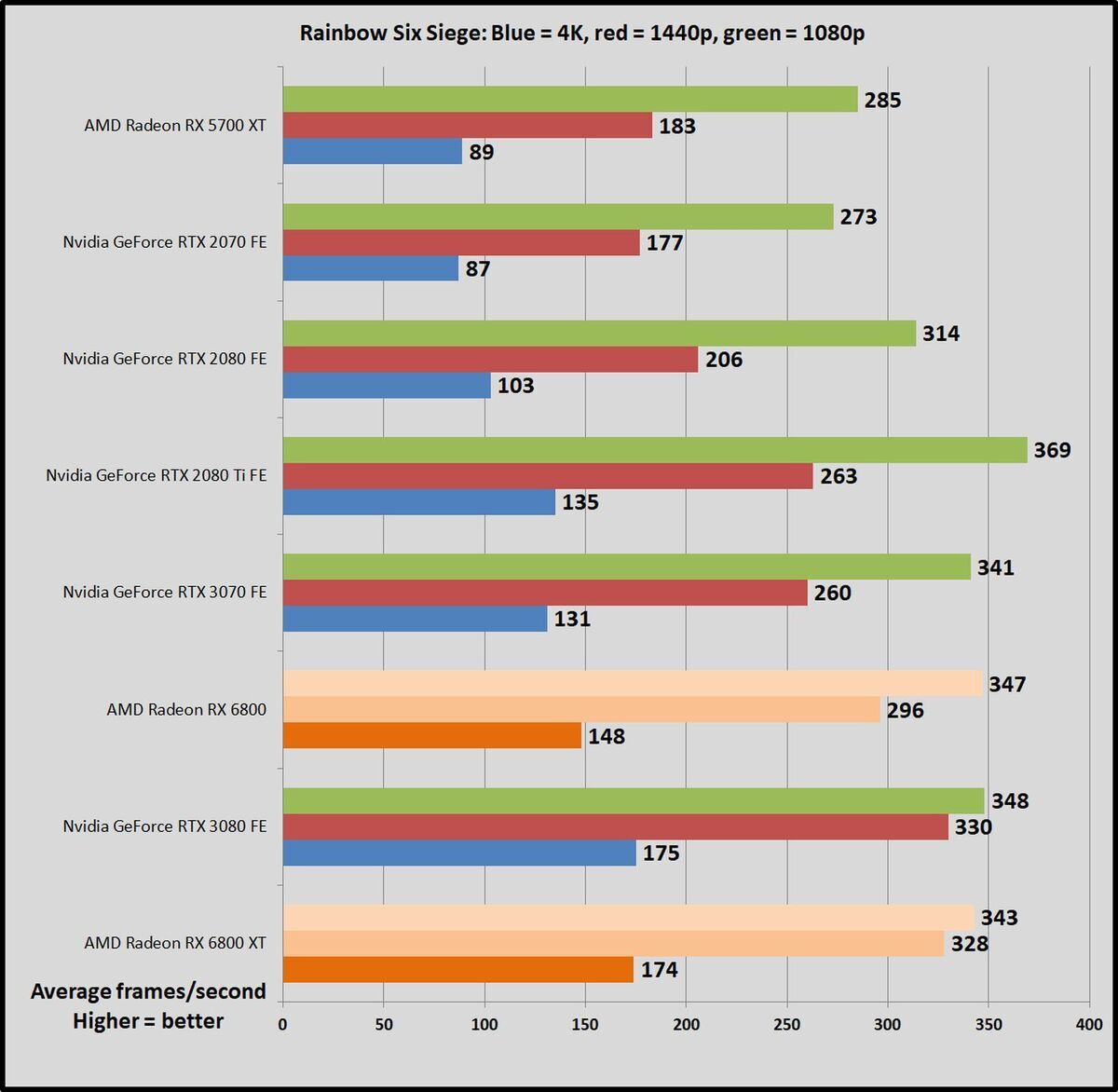 Brad Chacos/IDG
Brad Chacos/IDG Once once more, all of the malodourous-end cards being compared Hera hit CPU or engine bottlenecks at 1080p, with all option landing around 345 fps. The Radeon RX 6800 is close to 13 pct quicker than the RTX 3070 at both 4K and 1440p, piece the Radeon RX 6800 XT and RTX 3080 deliver essentially same performance across the display board.
Next page: Radeon RX 6800 and 6800 XT ray tracing public presentation
Radeon RX 6800 and 6800 XT ray trace performance
Now let's grasp a bit deeper into the new time period radiate tracing capabilities of AMD's graphics cards.
RDNA 2 marks the debut of irradiatio trace capabilities in Radeon graphics chips. Nvidia first introduced the applied science in the GeForce RTX 20-serial, and is now connected its second-generation effort with the RTX 30-series. As you'd expect, Nvidia's more mature technology delivers more performance, but how much more performance? We decided give Keep an eye on Dogs: Legion, Subway: Exodus and Shadow of the Tomb Despoiler a whirl to put it to the test. Hopefully we'll be able to revisit the issue with a wider selection of games later—the gorgeous Godfall didn't let in ray tracing at launch, alas—but for now, this trio of games represents a decent selection of various ray tracing personal effects. Host packs ray-traced reflections, Tomb Raider includes ray-traced shadows, and Metro features more effortful (and mood-enhancing) ray-traced world illumination.
Complicating things further is DLSS. Nvidia's Deep Learning First-rate Sampling feature renders games at a lower resolution, and then taps into dedicated tensor cores that use Bradypus tridactylus to upmarket the final image to your resolution. Because the game is existence rendered at lower resolution, your graphics card's traditional shading hardware can pump out frames faster, while DLSS's AI delivers shockingly good final prize. Well, now leastways. DLSS 1.0 suffered from some parturition pains, as covered in our RTX 20-series ray tracing retrospective, merely the novel DLSS 2.0 algorithms function beautifully.
Bottom line, though? DLSS is a key Nvidia advantage suitable now, particularly if you're interested in playing games with ray tracing active. AMD targeted playable 1440p performance with shaft tracing enabled on the Radeon RX 6800-series and largely hit those goals, but DLSS helps Nvidia's cards make much high frame rates, and even lets you play ray-traced games at 4K. AMD can't match that. The company has teased a "FidelityFX Super Resolution" feature that it hopes will rival DLSS and gain more adhesive friction inclined RDNA 2's comprehension in the next-gen consoles, but it's not here yet.
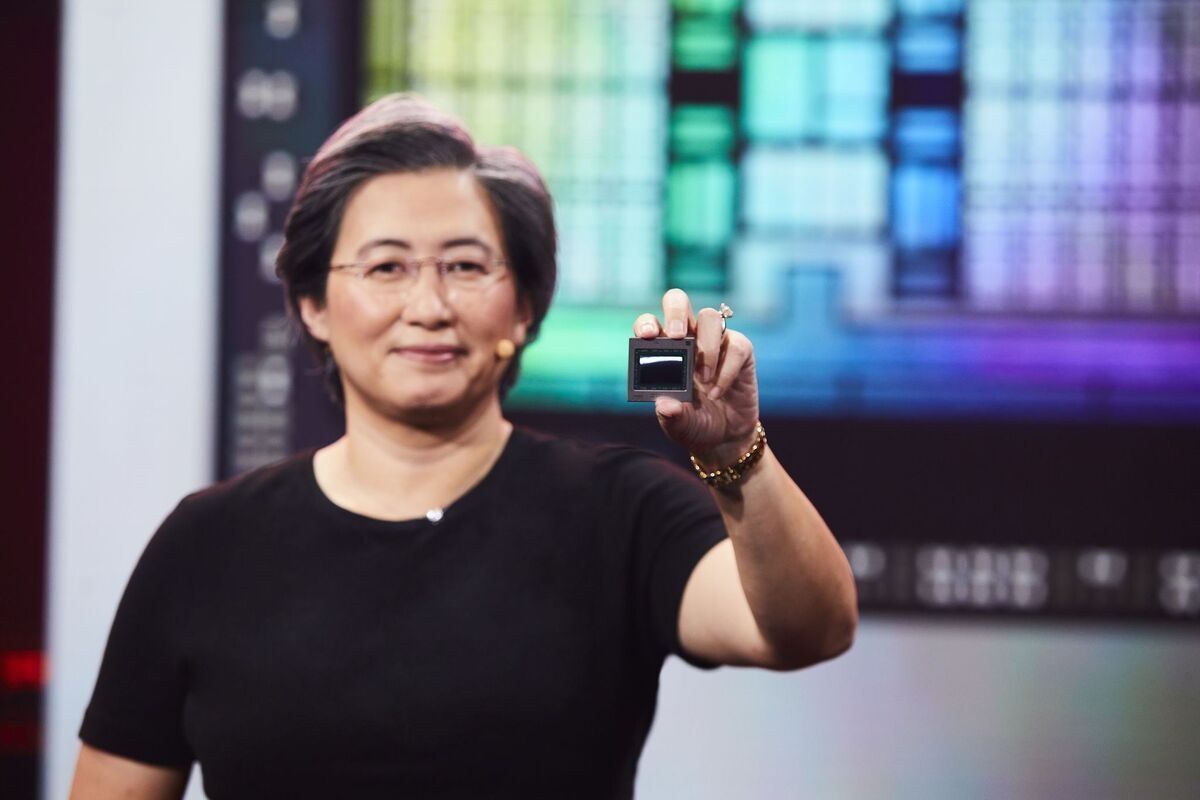 AMD
AMD RDNA 2 is AMD's first graphics architecture to substantiate concrete-time ray tracing.
It's also worth noting that since the Khronos group's re tracing support for Vulkan hasn't been formally discharged yet, some Vulkan games that currently support the technology were built using Nvidia extensions as a band-aid in the interim. That means you can't enable beam of light tracing in Wolfenstein: Youngblood, Quake II RTX, or the Asian title JX3 along the Radeon GPUs, at least for now. The option doesn't even come along in Youngblood. All other ray-traced games were built using Microsoft's DirectX Raytracing API, however, so they should work just pure happening both GeForce and Radeon computer hardware. Yes, that includes Cyberpunk 2077.
We've included three charts for all game—one for each star resolution. We split the results into several charts because we wished-for to show native performance, performance with only ray tracing on, and execution with ray tracing and DLSS on (for Nvidia cards) at apiece resolution to arrest a more complete picture of things. We set ray tracing to extremist for all titles; exploitation lower settings will have little of an impact.
Let's kick things off with Shadow of the Grave Raider's ray-traced shadows. The game includes the first-generation version of DLSS and doesn't support 1080p resolution, so we've stuck to cutting ray tracing performance.
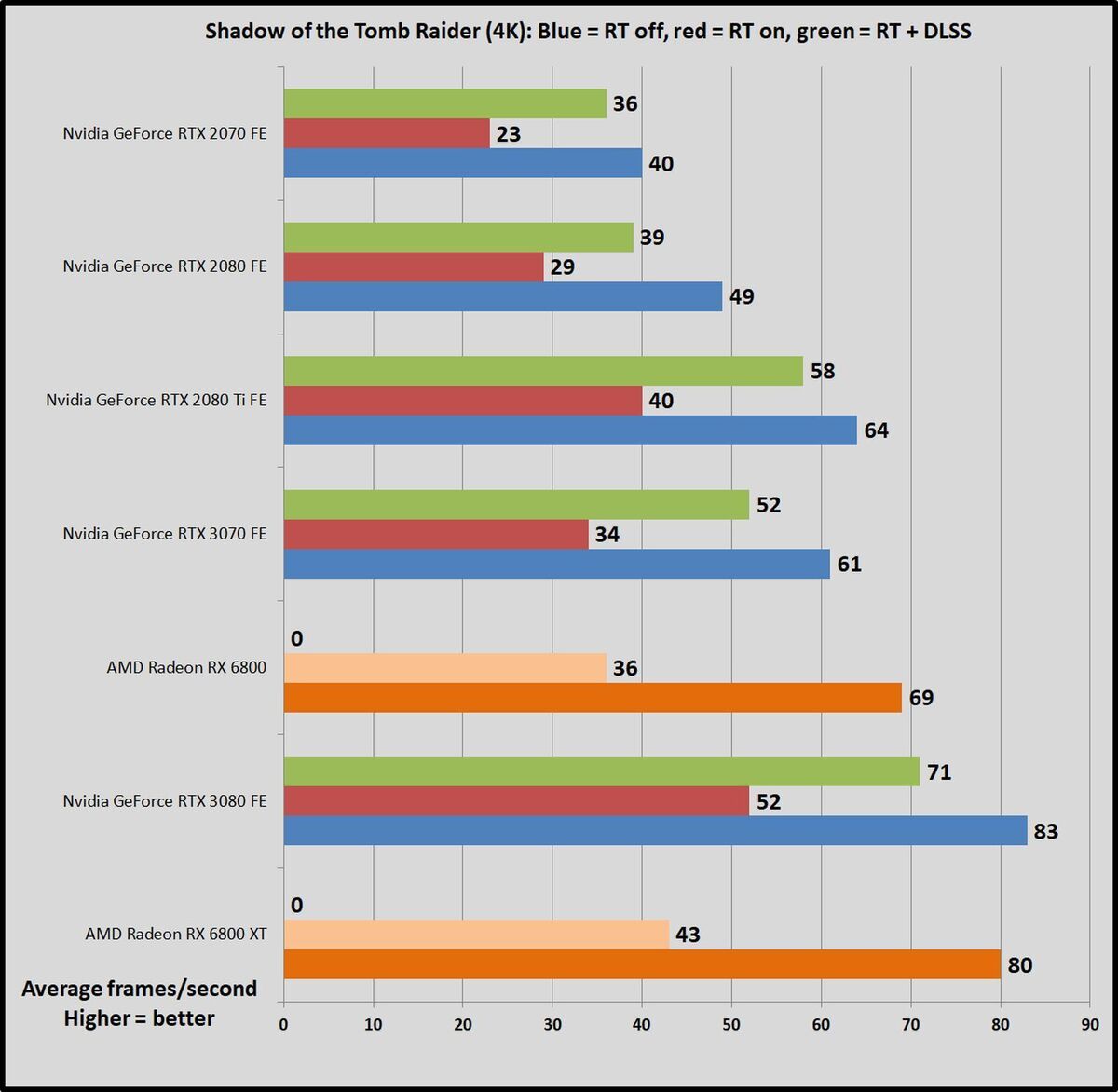 Brad Chacos/IDG
Brad Chacos/IDG  Brad Chacos/IDG
Brad Chacos/IDG 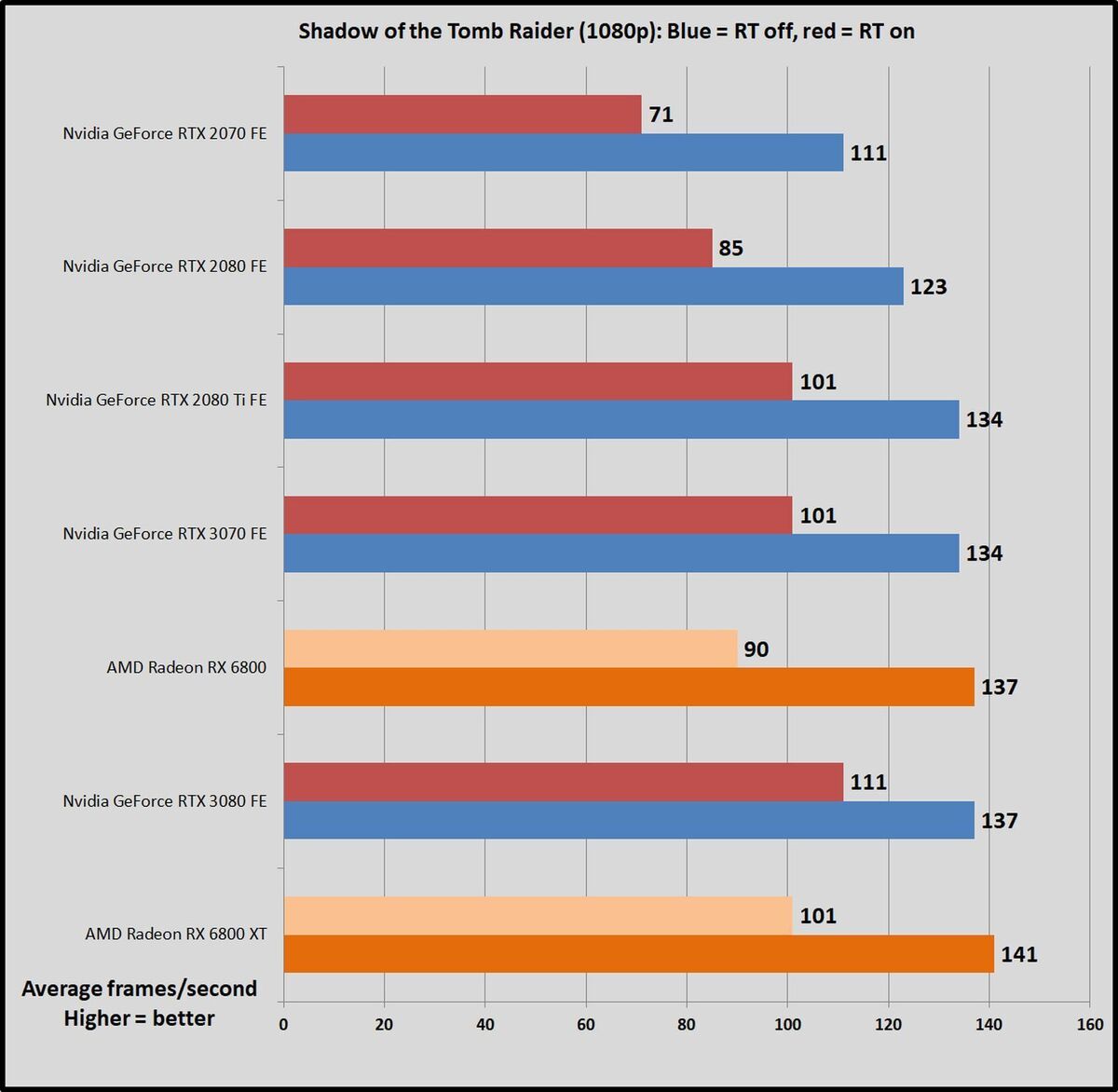 Brad Chacos/IDG
Brad Chacos/IDG Flipping on ray trace creates a titanic performance impact, as you'd expect, just it's bigger on Radeon GPUs. As you can see, even though the AMD cards perform faster than their GeForce rivals with ray trace off, they stimulate slower performance with ray of light tracing on. Ray trace slows the Radeon RX 6800 XT down by 41 percent at 1440p, and the Radeon RX 6800 away 46 percent. By contrast, Nvidia's RTX 3070 slows down 37 percent with ray tracing active, and the RTX 3080 slows down only if 28 percent.
The Radeon RX 6800 and 6800 XT exceed the hallowed 60-fps mark at 1440p resolution and clear 90 fps at 1080p. Flipping on DLSS gives Nvidia a massive performance lead, withal, and it delivers enough extra oomph to let you play the game at 4K resolution on GeForce hardware. You won't beryllium able to do that with the Radeon RX 6800-series unless you dial back some visible settings.
Metro: Exodus uses ray tracing for global illumination. IT also uses DLSS 1.0 and doesn't financial backing the upscaling feature at 1080p, so we've included only raw ray tracing performance along that chart.
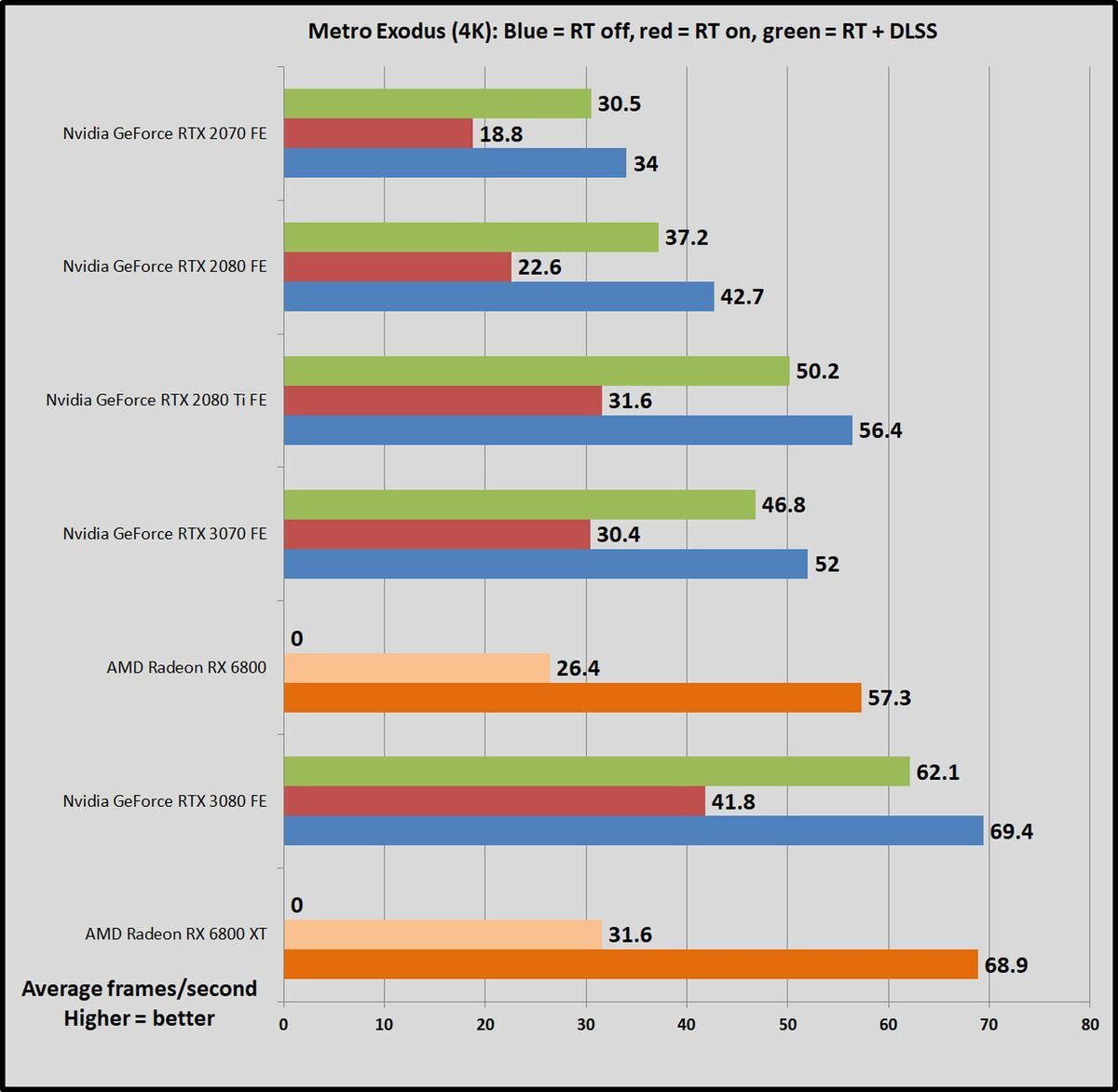 Brad Chacos/IDG
Brad Chacos/IDG 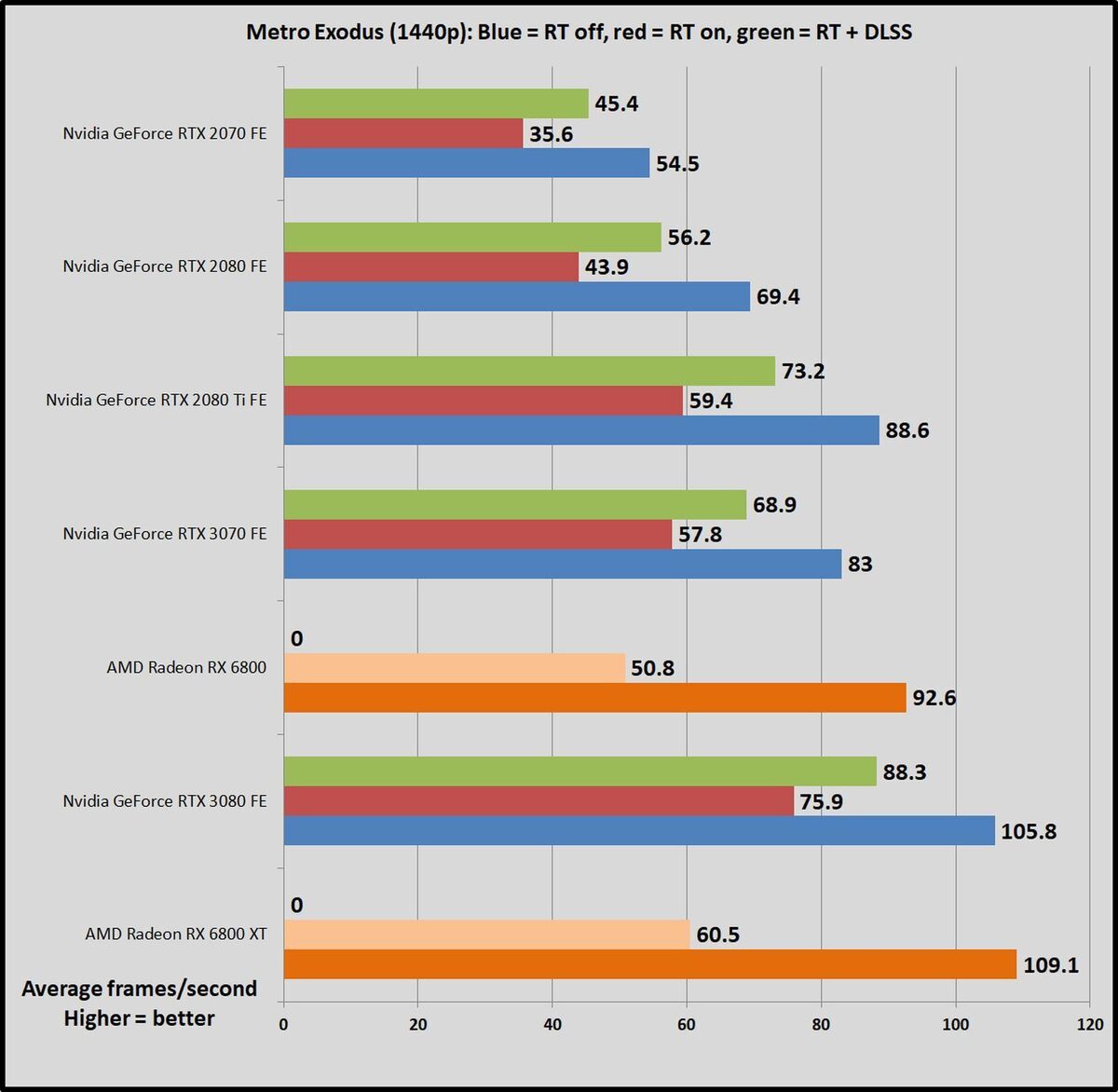 Brad Chacos/IDG
Brad Chacos/IDG 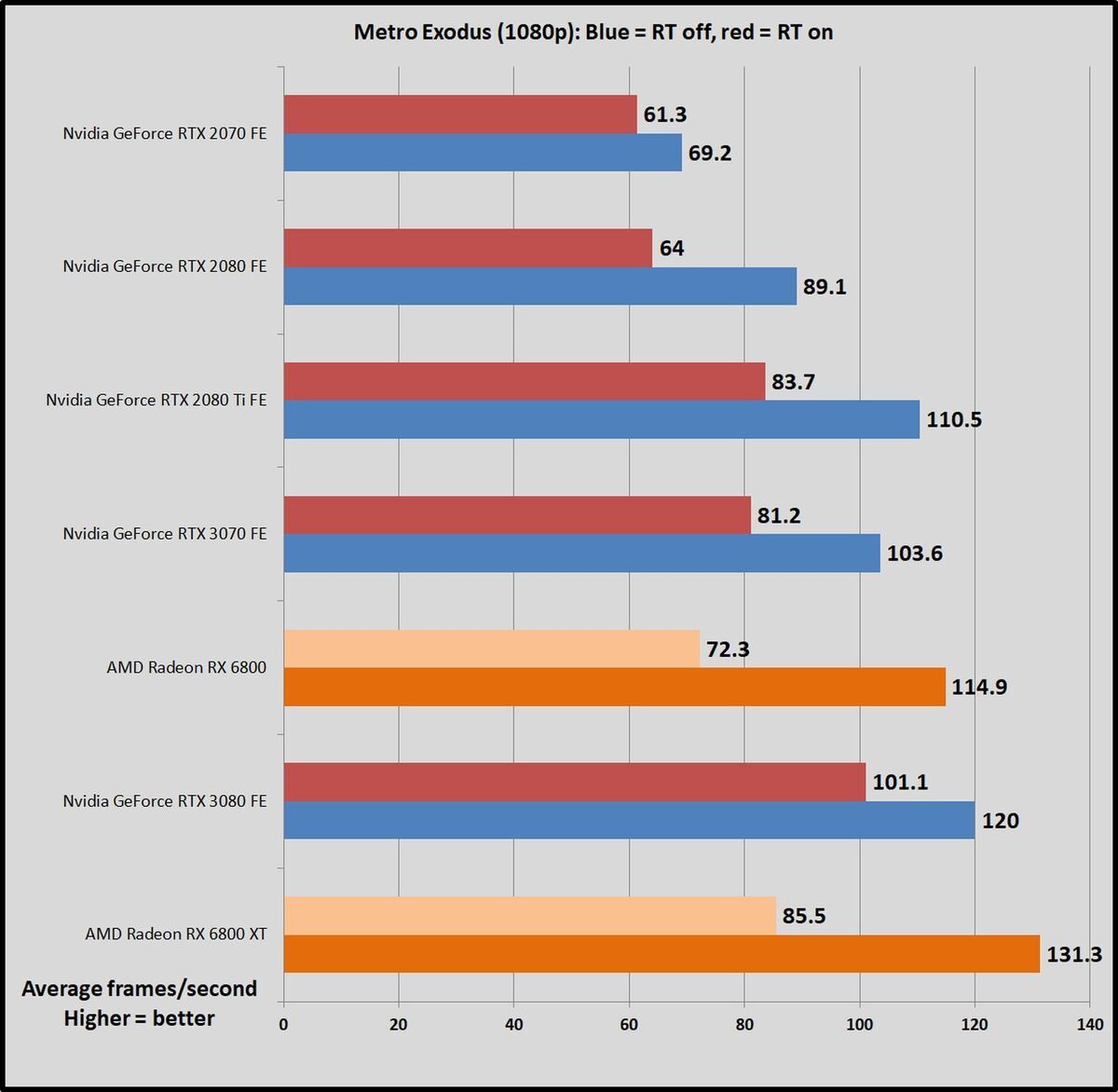 Brad Chacos/IDG
Brad Chacos/IDG Ray tracing reduces the performance connected both Radeon RX 6800-series cards away 45 pct at 1440p. The RTX 3080 only loses 28 per centum off the top, while the RTX 3070 loses 30 percent. Flipping connected DLSS over again extends Nvidia's lead. That said, the Radeon GPUs indeed accomplish playable frame rates at 1440p and 1080p, though you leave need to tinker with some visual settings to hit 60 fps at 1440p. GeForce card game can leverage DLSS to play with ray tracing along at all resolutions, though you'll besides need to fine-tune extraordinary things to bring them running at 60 fps at 4K.
Watch Dogs: Legion hammers your system regardless of whether you bear ray tracing on. None of these cards sustain 60 fps at 4K resolution even with the cutting-edge lighting effects turned off, leastwise with the high-resolution texture pack installed. Activating the ray-traced reflections exacerbates the issue. Unlike Tomb Raider and Metro, Watch Dogs uses the quicker, punter DLSS 2.0 technology. We test it with DLSS Well-balanced mood active. Balanced lets you hit higher frame rates than the Quality mode, but the even quicker Performance mode starts to introduce visual differences you fire notification in some scenes. Equal hits the musical spot.
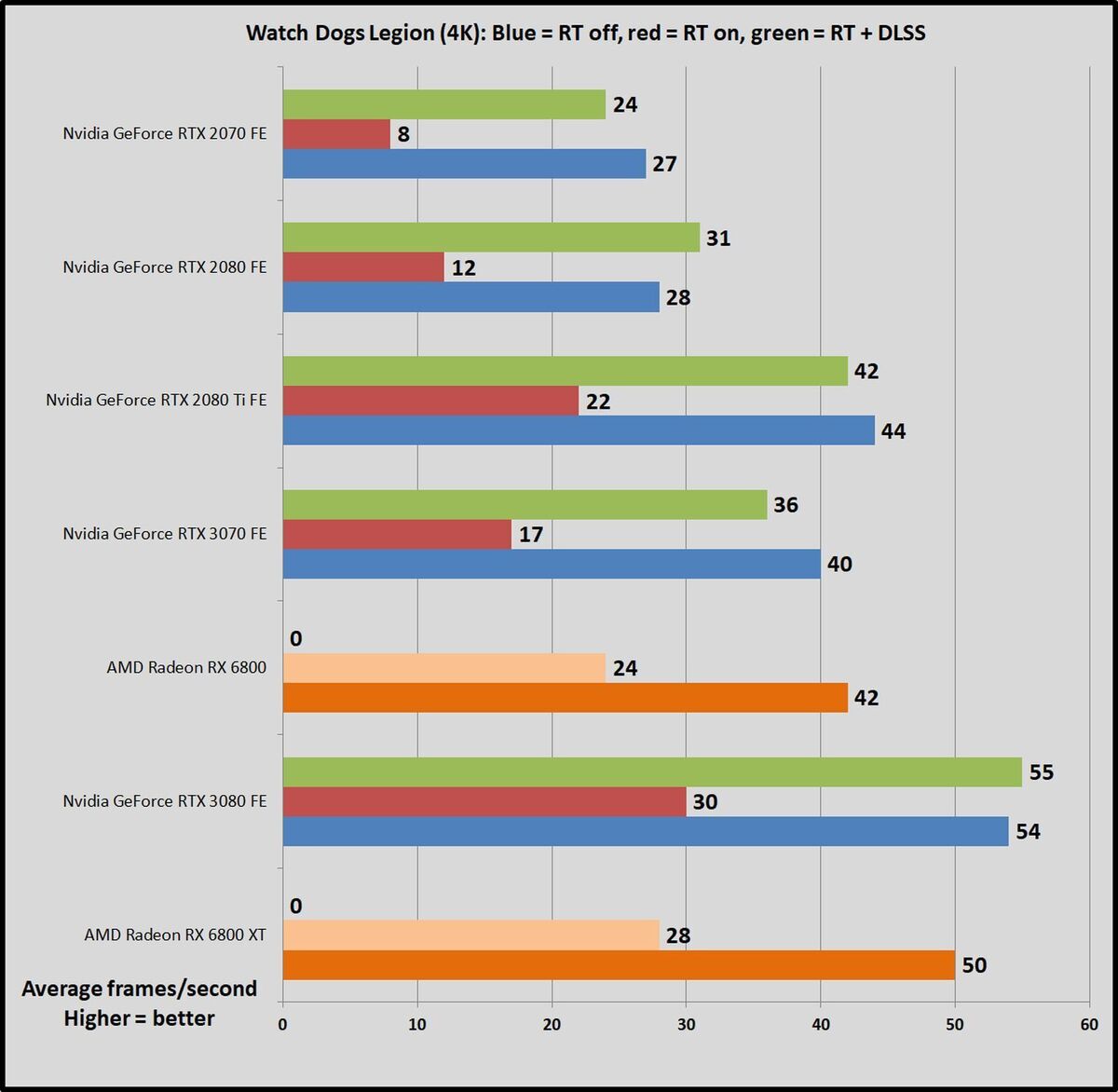 Brad Chacos/IDG
Brad Chacos/IDG 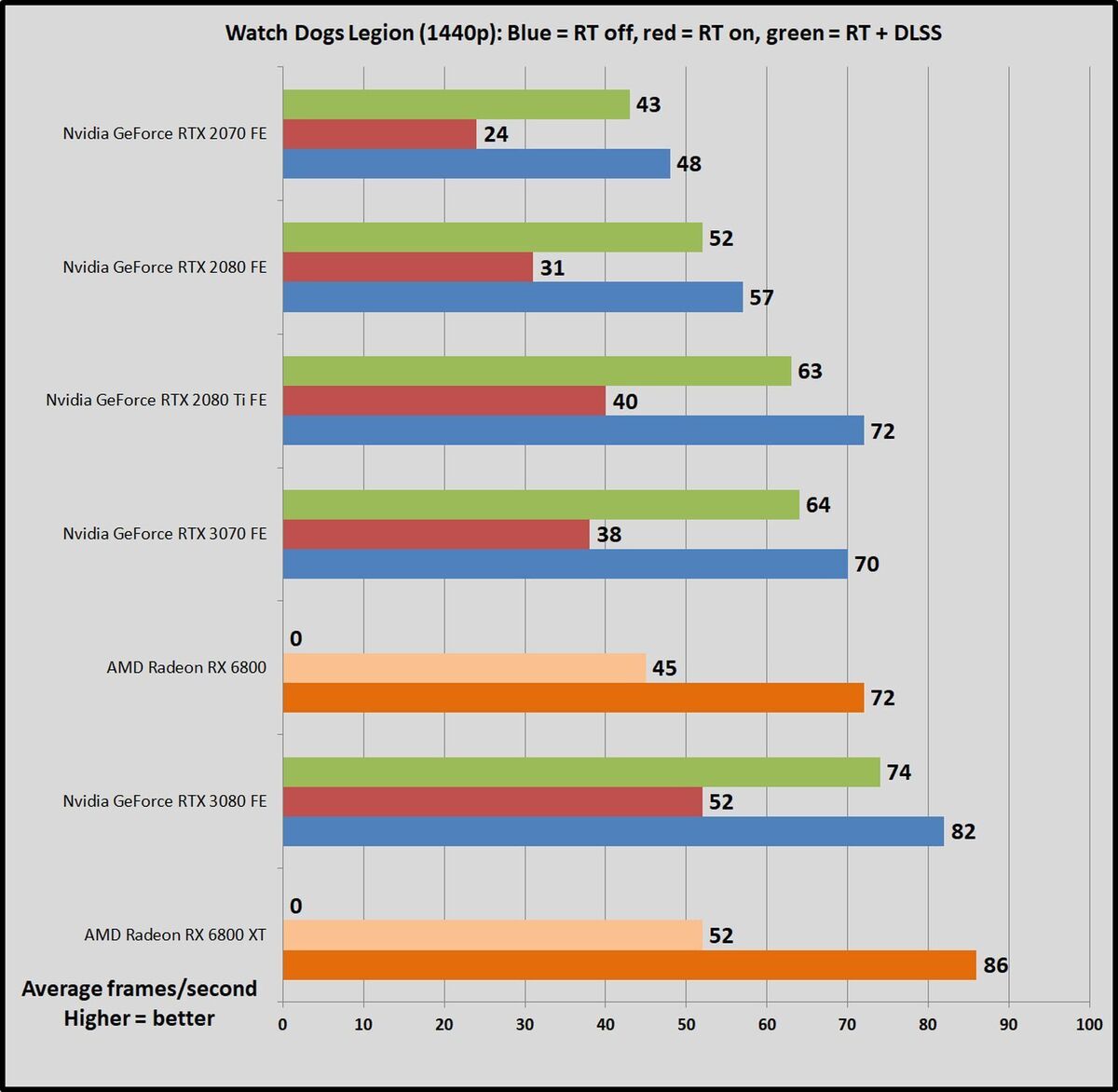 Brad Chacos/IDG
Brad Chacos/IDG 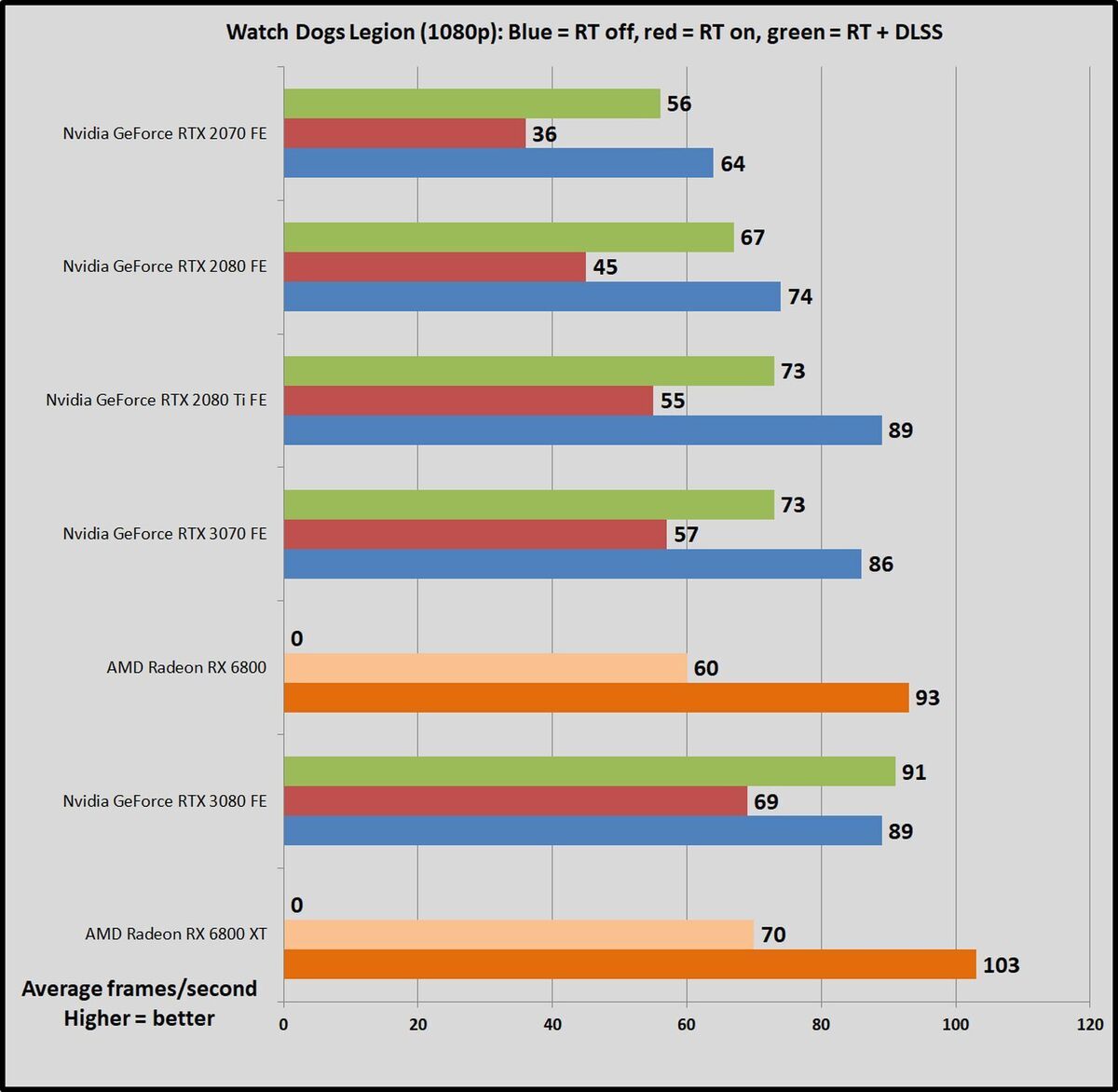 Brad Chacos/IDG
Brad Chacos/IDG The Radeon RX 6800 XT is 40 pct slower with ray of light tracing connected at 1440p solution, patc the Radeon RX 6800 is 38 percent slower. By contrast, the RTX 3080 is 37 per centum slower, while the RTX 3070 is 45 percent slower. You as wel can see that the Radeon RX 6800 delivers better irradiatio trace performance than Nvidia's last-gen card game by comparing this result against the RTX 2080 Ti.
Interestingly, the Radeon GPUs suffer a bit less of a performance punishment than they do in the strange games, while the GeForce card game get hit a trifle harder. This game uses enceinte amounts of memory, exceptional the RTX 3070's 8GB capacity eventide at 1440p with ray tracing away. Turn information technology on increases the demands further. The beefier 16GB of memory connected AMD's cards aid return them an edge present, letting the Radeon RX 6800 XT match the RTX 3080's performance with ray tracing on at 1440p, while the RX 6800 is 18 percentage faster than the RTX 3070.
That lead disappears once you flip on DLSS, of path, but information technology's an encouraging sign for AMD's innovation decisions. The RTX 3080 cannot hit 60 fps at 4K resolution symmetric with DLSS enabled, and the 3070 force out't reach 40 FPS. AMD's cards once once again deliver playable human body rates at 1440p and 1080p, though they can't quite hit 60 fps with all the visual bells and whistles cranked at 1440p. That's more acceptable in an unresolved-world third-person game like Legion, but you should easily be able to get to 60 fps by tinkering with various modality options.
All in all, the Radeon RX 6800-series GPUs deliver jelled ray tracing carrying out at most commonly played resolutions, 1440p and 1080p. Nvidia's second-gen implementation has a performance vantage, and DLSS extends it even further. Ray tracing hits memory hard, though, and the large VRAM capacity in the Radeon GPUs might embody an advantage for them in futurity titles, like it is in Watch Dogs currently.
Next page: Power, thermals, and haphazardness
Power draw play, thermals, and noise
We test major power draw by looping theF1 2020 benchmark at 4K for about 20 proceedings after we've benchmarked everything else and noting the highest reading on our Isaac Watts Up Professional meter, which measures the power consumption of our entire test system. The first part of the race, where all competitive cars are onscreen simultaneously, tends to be the all but demanding portion.
This isn't a worst-case test; we removed the Heart i7 8700K's overclock and specifically chose a GPU-bound game running at a GPU-bound resolution to gauge carrying out when the graphics card is sweating hard. If you're playing a game that also hammers the C.P.U., you could get a line higher overall system big businessman draws. Consider yourself warned.
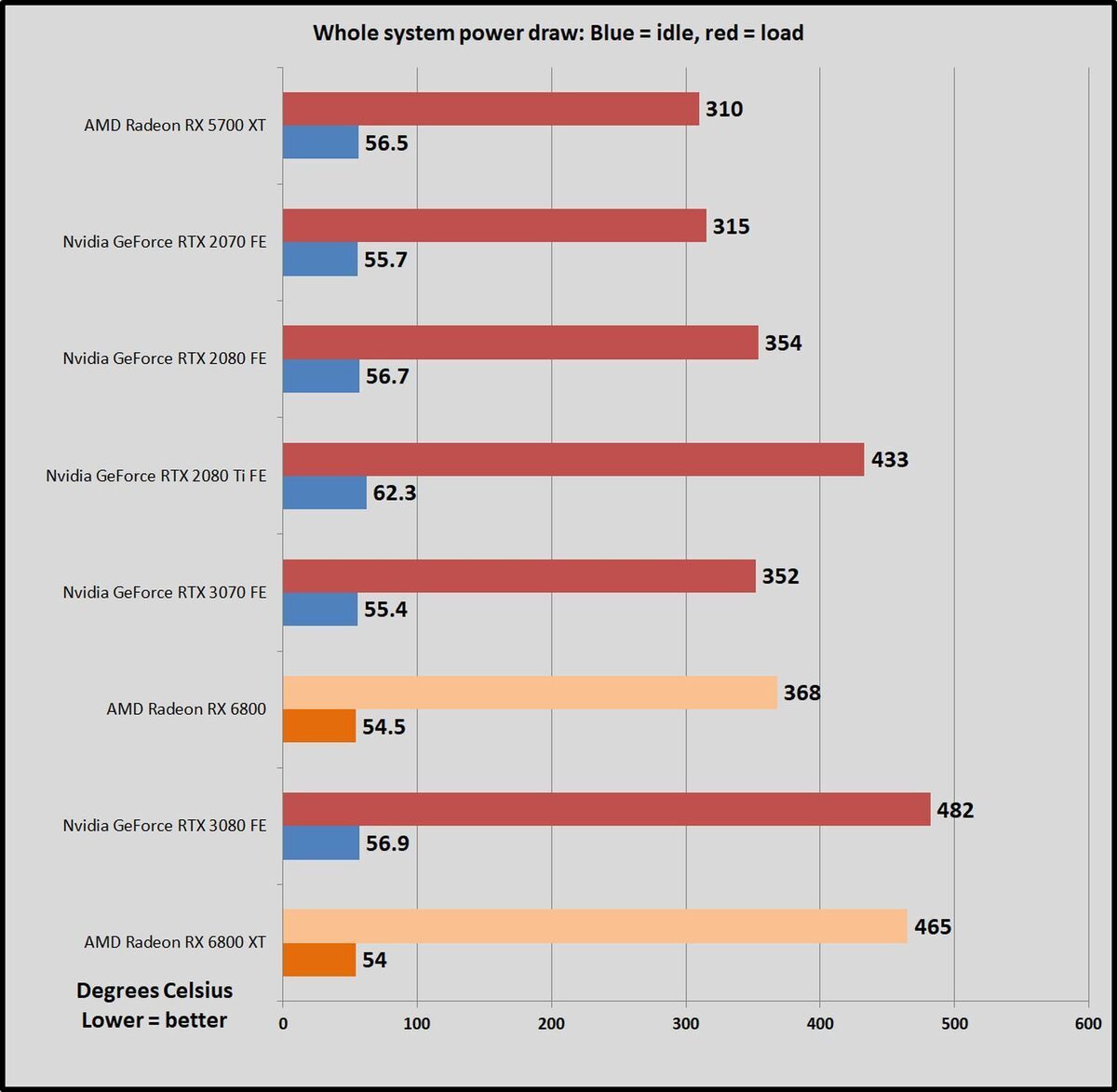 Brad Chacos/IDG
Brad Chacos/IDG You can insure the improved efficiency of the RDNA 2 computer architecture in the Radeon RX 6800 XT's results. Disdain trading blows with the RTX 3080 at 4K and oft beating information technology outright at 1440p play, AMD's card uses less power than its equal. The reduction Radeon RX 6800 is flat-out more powerful than the RTX 3070, so information technology's no surprisal to see it draw somewhat more magnate than the GeForce card. That said, the RX 6800 barely uses Thomas More business leader than the RTX 3070 and also packs in twice arsenic a great deal RAM. It's a good showing for AMD.
We test thermals by going away GPU-Z open during theF1 2020 powerfulness draw test, noting the highest maximum temperature at the conclusion.
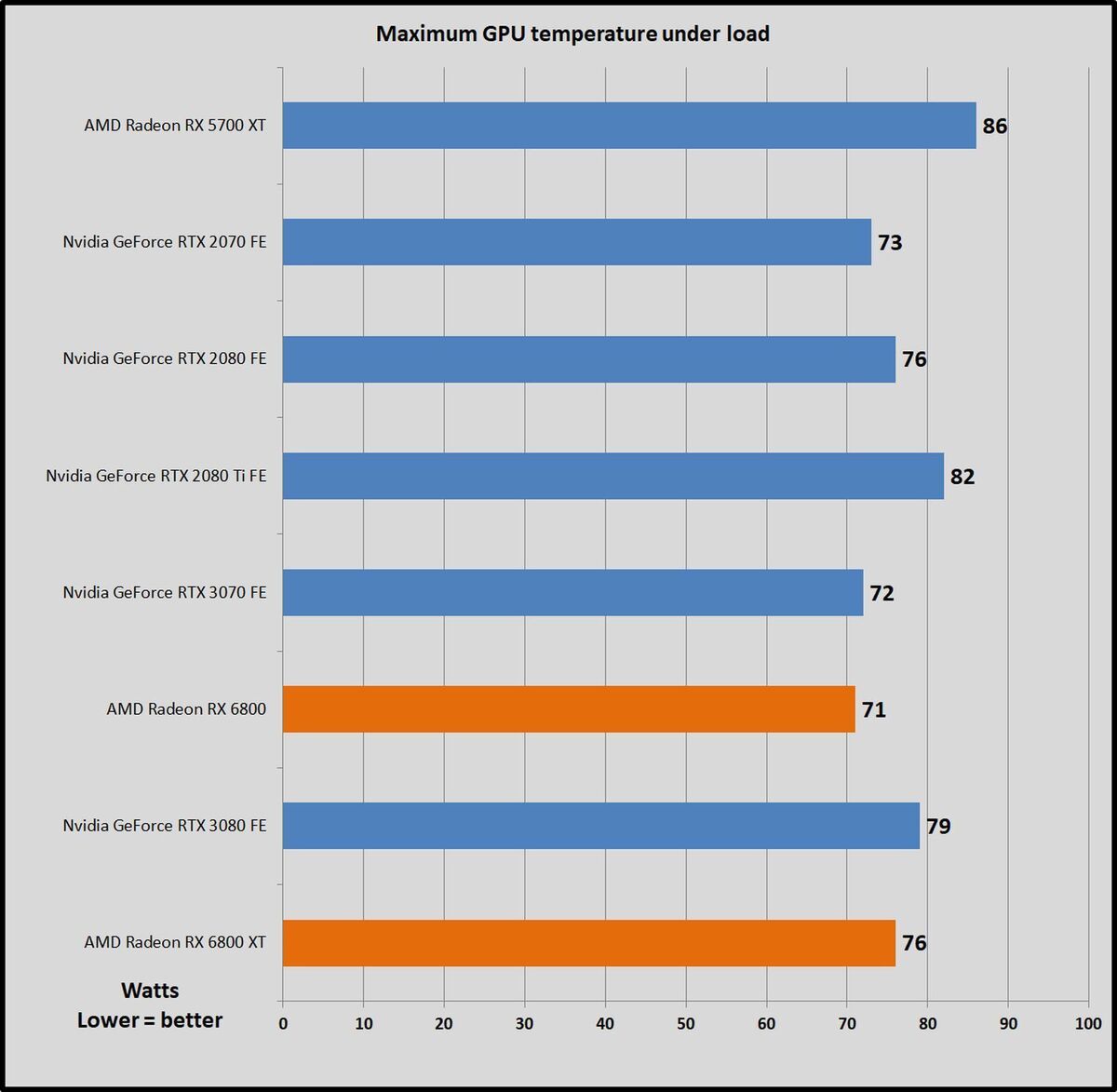 Brad Chacos/IDG
Brad Chacos/IDG AMD's switch to axial cooling delivers solid results, and a tremendous improvement over previous Radeon reference boards. The ultra-powerful Radeon RX 6800 XT maxed out at 76 degrees Celsius in our system of rules, a whopping 10 degrees below what the blower-fashio cooler on the last-gen Radeon RX 5700 XT hits—and that was a midrange GPU.
Nvidia's immoderate "flow-through with" temperature reduction organization with its whole-form rut sink helps the RTX 30-series Founders Edition cards run much many quietly than AMD's Radeon RX 6800-series options. The Radeon RX 6800 and 6800 XT nevertheless reach perfectly acceptable make noise levels, unlike the blower coolers of old. You'll hear these card game when you're gaming, yes—in that location's still room for AMD's custom board partners to innovate here—but not anywhere near annoying levels. The Radeon RX 6800 XT is louder than the 6800 scorn its extra half-slot of heatsink capacity, and our model exhibited faint coil whine when it hit particularly high cast rates in Strange Brigade and Rainbow Six Siege. That can happen to any item-by-item card, and we exclusively noticed information technology only when the 6800 Crosstalk was pumping out different 100 frames per second.
Bottom line? These are good coolers, with nothing to plain about—something you couldn't say about AMD reference boards in the past.
Incoming page: Should you buy the Radeon RX 6800 and 6800 XT?
Should you buy the Radeon RX 6800 or 6800 XT?
Definitely. The Radeon RX 6800-series is a stunning return to the high end for AMD, proving that yes, Team Colored can still go blow-for-botch with Nvidia's height offerings. These are outstanding graphics cards.
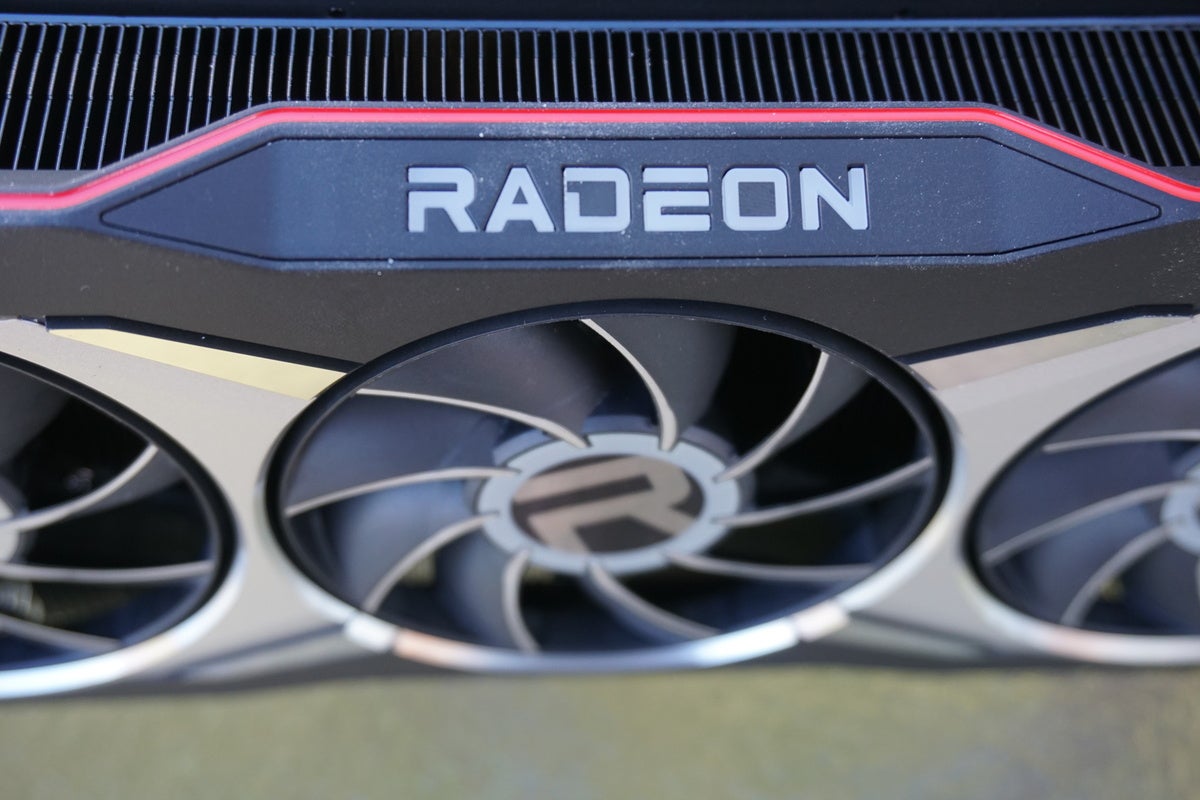 Brad Chacos/IDG
Brad Chacos/IDG The $580 Radeon RX 6800 triumphs over the $500 GeForce RTX 3070 in most situations. The $650 Radeon RX 6800 XT trades blows with the pricier $700 GeForce RTX 3080 at 4K, simply typically surges past its rival as you move down pat to 1440p and 1080p resolution. That's the common performance composition. Nvidia loaded its Ampere computer architecture with abundant CUDA cores that deliver excellent 4K performance, but the RTX 30-series struggles to keep down all those cores fed at lower resolutions. AMD's RDNA 2-based graphics card game scale down much more graciously. If you're provision to steal any of these $500-plus graphics cards for usage with a high-refresh-value 1440p or 1080p monitor, AMD is the clear prime.
The Radeon RX 6800-series delivers at 4K, too. The Radeon RX 6800 beats the RTX 3070 by a jelled amount in most games, spell the Radeon RX 6800 Crosstalk and RTX 3080 roll up sprouted within 5 frames of all other in everything but Crazy Brigade, where Nvidia's card wins by 9 percent.
AMD holds a key store advantage for high-resolution gaming, too. Some of these card game come equipped with 16GB of GDDR6 memory, bolstered by the on-die 128MB "Infinity Cache." By contrast, the RTX 3070 has 8GB of GDDR6, and the RTX 3080 has 10GB of quicker GDDR6X memory. Some of today's games already take more than 8GB at 4K solving. Rare titles utilisation more than 10GB.
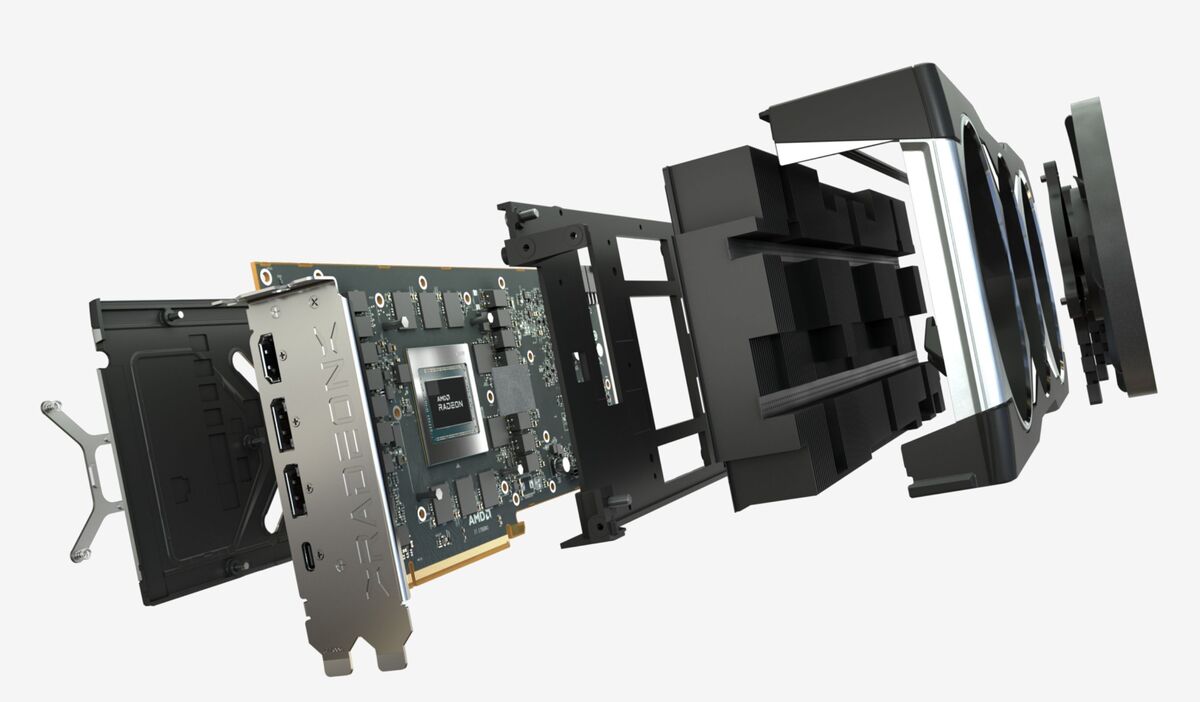 AMD
AMD There's an ample 16GB of GDDR6 memory built into the Radeon RX 6800-serial publication GPUs, a key advantage.
Devising matters worse for Nvidia, retentivity demands go risen when you aerate ray tracing, and new consoles just launched with larger computer memory pools than past generations. You won't have to worry just about AMD's ample 16GB memory buffer linear out of capacity for the predictable, but you mightiness indigence to scorn texture settings on GeForce cards in a year or two.
Speaking of ray trace, the stylish lighting engineering makes its debut in AMD's RDNA 2 computer architecture. The technology is very intensive and creates a huge carrying into action bear upon along any GPU. The Radeon RX 6800 and 6800 XT oversee to achieve playable frame rates with ray tracing on at 1440p and 1080p resolve, especially if you don't mind tweaking some settings, but not 4K. That's a bummer. The GeForce RTX 30-series' s-gen RT core carrying out keeps performance higher than AMD's ray of light accelerators, however, and AMD has no account Nvidia's A-one DLSS 2.0 technology that uses AI upsampling to claw back performance irrecoverable to all those peppy rays. DLSS enables 4K gaming with ray tracing on. AMD has teased a more candid DLSS rival dubbed "FidelityFX Super Resolution," but it's some mysterious and unobtainable for directly.
If great performance in ray-traced games is a goal for you—specially in games that use tidy sum of re-traced personal effects, like Minecraft RTX or Hacker 2077—then Nvidia is the clear superior. That said, the 8GB memory buffer already slows down the RTX 3070 with ray trace on in Watch Dogs: Legion. Decisions, decisions.
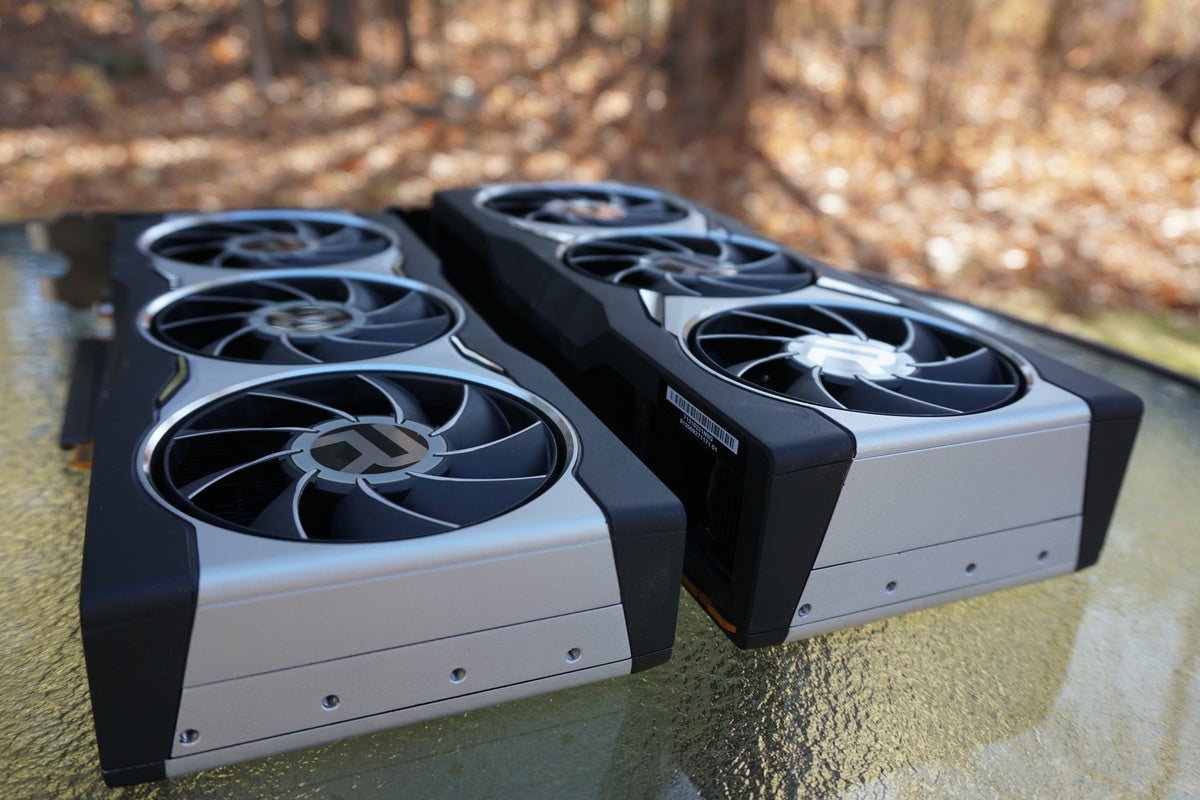 Brad Chacos/IDG
Brad Chacos/IDG AMD talks fallen close to Nvidia's ecosystem of proprietary features, but Jet Team tools like G-Synchronize, DLSS, Nvidia Reflex, Nvidia Broadcast, Shadowplay, NVENC, and CUDA optimizations in creative workloads are wholly worthy reasons to forsake Team Red River. AMD counters many of those with excellent features of its own—PR is keen to breaker point out that pairing Radeon Boost with Radeon Opposed-Lag challenges Nvidia Involuntary, for lesson—but Nvidia invests a fate in its software program ecosystem and has earned consumer trust over the years that AMD is distillery trying to win back. And again, the lack of a DLSS rival hurts, particularly because some games that don't support ray tracing are starting to include DLSS to boost performance.
AMD has a nifty deck out its ain arm, though: Smart Access Memory. If you pair a Radeon RX 6000-series GPU with a Ryzen 5000 C.P.U. in an X570 motherboard, you'll realise carrying into action increases of varying amounts in varying circumstances—in excess of 10 percent in the most favorable conditions, per AMD. It's built using the PCIe spec's Resizeable BAR attribute, so Intel and Nvidia whitethorn counter the engineering with future BIOS updates, just for now, Smart Access Memory serves Eastern Samoa the groundwork of AMD's Ryzen-and-Radeon "Last-ditch Gaming Political program" pitch. We weren't able to tryout it yet for this refresh, but stay tuned for an in-depth analysis soon.
Phew! Art cards sure are a lot more complicated than they in use to be. Let's bring in it all unneurotic.
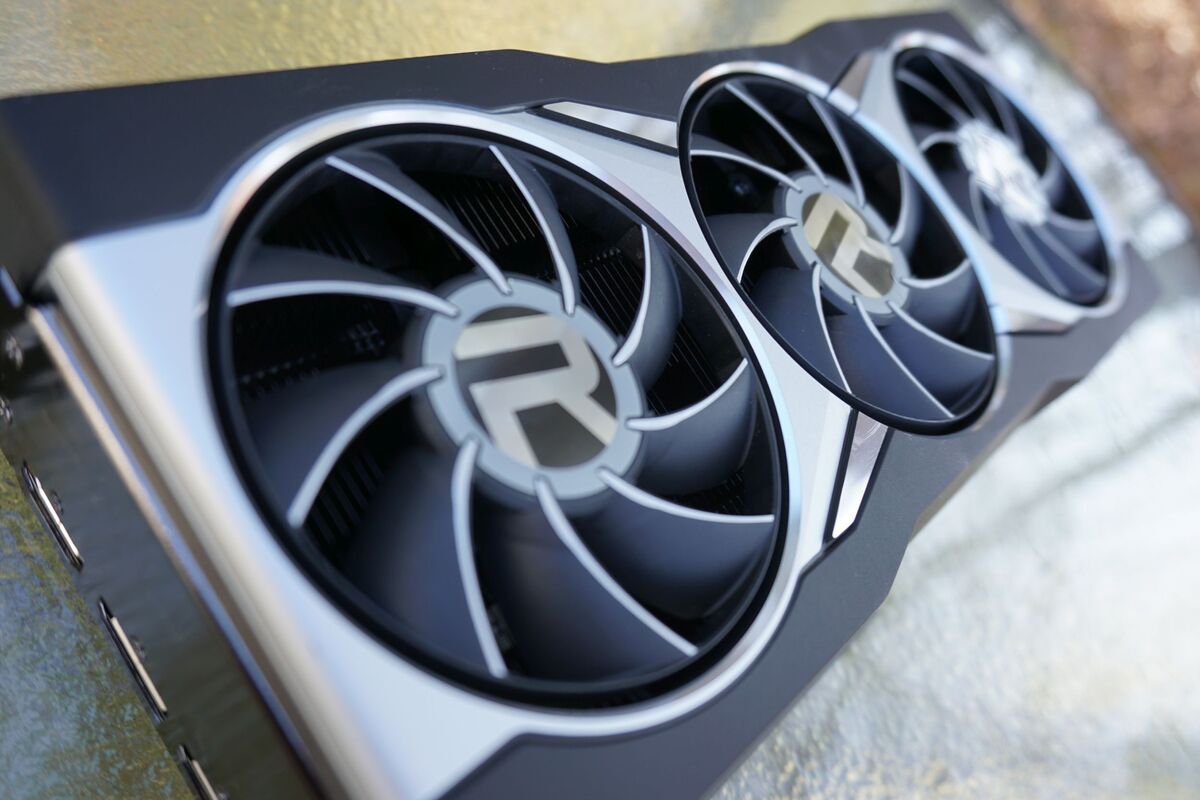 Brad Chacos/IDG
Brad Chacos/IDG The $580 Radeon RX 6800 smokes the RTX 3070 in everything just ray trace. Information technology's faster at 4K, information technology's faster at high-refresh range 1080p, and it packs twice as much memory, which feels significantly to a greater extent future proof for the higher resolutions this card targets. If AMD priced the placard closer to the RTX 3070's $500 cost it would be a walk-hit home move. As-is, the GeForce RTX 3070 is notwithstandin worth considering for 1440p gaming given its substantially bring dow price tag, but I'd recommend spending dormy for the Radeon RX 6800—more for the increased VRAM than the raw performance. The 8GB capability of the RTX 3070 is already limiting in some titles, and not just at 4K.
The $650 Radeon RX 6800 XT is also mighty seductive. Compared to the GeForce RTX 3080, it delivers comparable 4K performance, faster 1440p and 1080p performance, and 6GB more memory capacity, entirely for $50 less than Nvidia charges. Nvidia's card uses faster GDDR6X memory, only raw capacity will probably make a bigger difference for 4K gaming in the geezerhood to fare. The Radeon RX 6800 XT may be $650, but it delivers incredible value versus the challenger.
Ray trace operation, other Nvidia ecosystem features, and determinant DLSS support could rock you toward Squad Green, especially if you'rhenium already entrenched. The GeForce RTX 3070 and 3080 persist superior cards that recently attained high marks in our reviews. Only strongly consider joining the Red Team this prison term around. The Radeon RX 6800-serial meets or beats the performance of its GeForce rivals in most fate and offer tangibly more memory capacity—a key metric linear unit at these rarefied resolutions. I'm a massive believer in DLSS 2.0, but if I were spending my personal money, I'd probably put to sleep my cash downfield on the Radeon GPUs, particularly since I'm not a streamer surgery content Divine who of necessity Nvidia's excellent software program ecosystem.
Receive back to the high end, AMD. The Radeon RX 6800 and RX 6800 Crosstalk will melt your face. I sack't wait to see what the $999 Radeon RX 6900 XT can achieve when it launches Dec 8.
Note: When you buy out something after clicking links in our articles, we whitethorn earn a small commission. Read our affiliate connection policy for more details.
Source: https://www.pcworld.com/article/393729/amd-radeon-rx-6800-rx-6800-xt-review.html
Posted by: garciaeary1996.blogspot.com

0 Response to "AMD Radeon RX 6800 and RX 6800 XT review: Reclaiming the high end - garciaeary1996"
Post a Comment